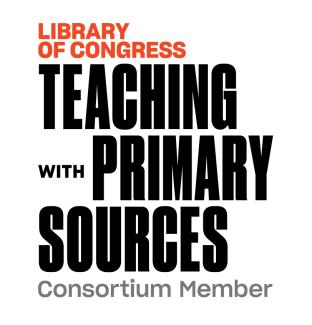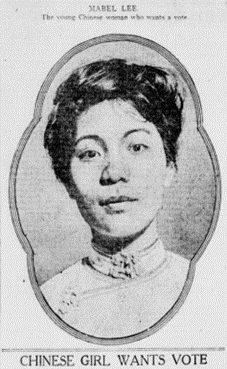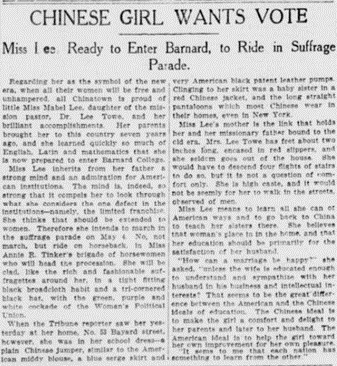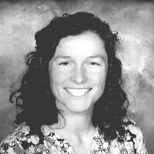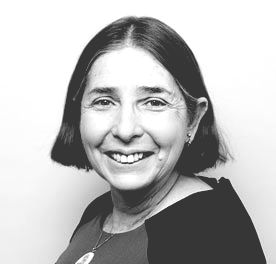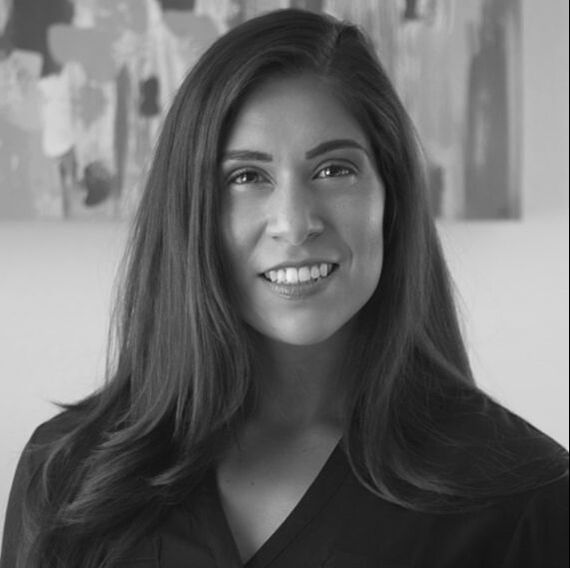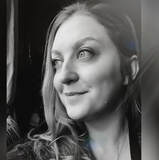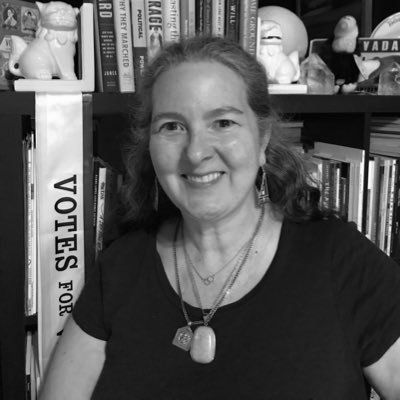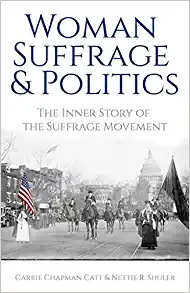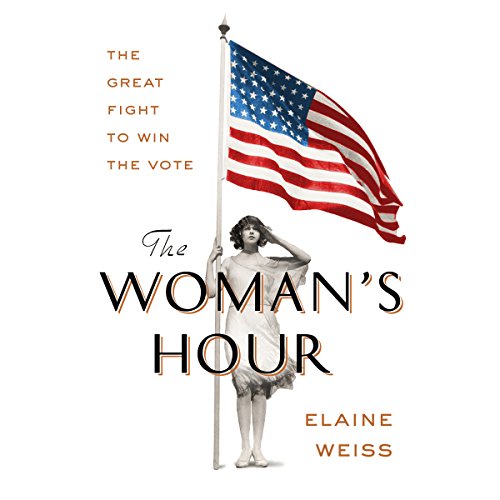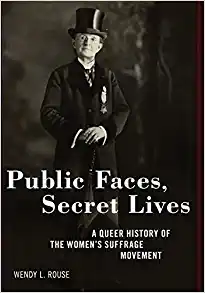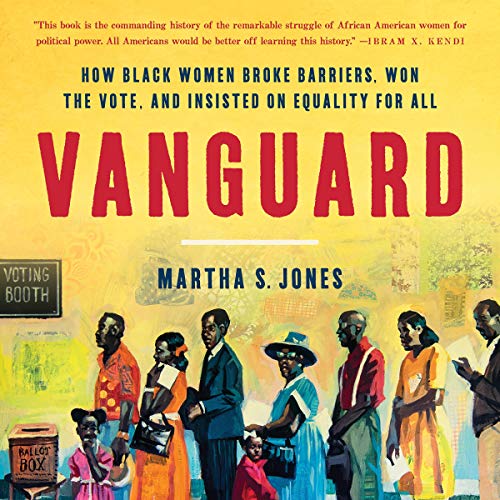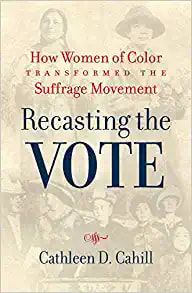16. Final Push for Woman Suffrage
|
The first wave of suffragists were gone. It was up to a new, educated, and persistent generation of women to earn the right to vote. This final push for women's suffrage saw pageants, parades, marches, boycotts, silent sentinels, hunger strikes, in addition to all the tactics used before. When World War I broke out, women did not back down as they had during the Civil War, escalating the attention to the movement. Women's suffrage eventually passed as a war measure.
|
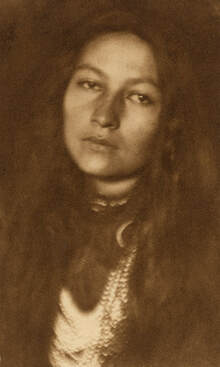 Zitkala Sa, Wikimedia Commons
Zitkala Sa, Wikimedia Commons
As the women’s suffrage movement in the United States entered a new century, most of its original leaders were now gone. Elizabeth caddy Stanton, Susan B Anthony, Lucretia Mott, and the other white women who were instrumental in the founding of the national American women’s suffrage Association were dead. It was up to a new generation of young college educated women to navigate the tricky dynamic of advocating for political reforms without having an official voice in politics. New leaders emerged like Carrie Catt, Ida B Wells Barnett, Alice Paul, and Lucy Burns. Although their advocacy and focus may have varied, these women lead the national movement in its final push to gain women’s suffrage. State to state suffrage leaders emerged and helped advocate for reform on a state level. There are also leaders like Zitkala Sa and Mabel Ping-Hua Lee who advocated for groups that were yet to be even recognized as citizens, like Native Americans and Chinese Americans.
What were these women and their allies after? A democracy that recognized them as full citizens. Named after Susan B. Anthony who first introduced in 1878, the amendment stated simply: “The right of citizens of the United States to vote shall not be denied or abridged by the United States or by any State on account of sex.”
That one sentence took decades of work, sweat, tears, and violence to pass.
What were these women and their allies after? A democracy that recognized them as full citizens. Named after Susan B. Anthony who first introduced in 1878, the amendment stated simply: “The right of citizens of the United States to vote shall not be denied or abridged by the United States or by any State on account of sex.”
That one sentence took decades of work, sweat, tears, and violence to pass.
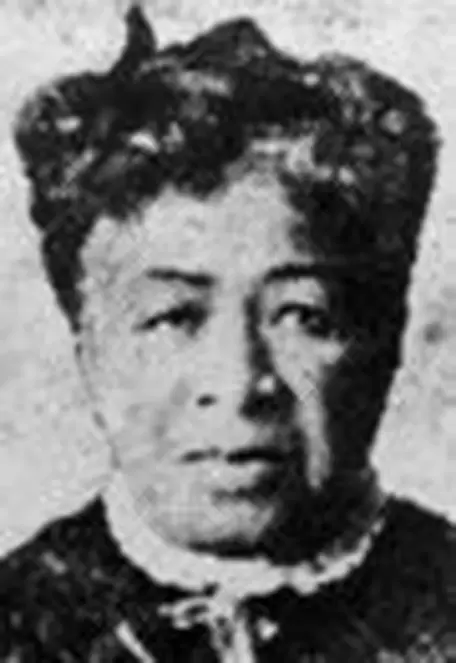 Lucy Stanton
Lucy Stanton
College Degrees:
To discuss women’s suffrage in this period, it would be impossible to ignore the role that educational reforms played in the lives of the new generation of women leading the charge. Young women at the turn of the century were attending college at rates never before seen. These women entered into college classrooms where no women have done before. Most often they were not greeted with open arms. In fact they were greeted with hostility. They were often seen as taking a seat from a young man, “who would actually use his degree.“ Young female college students were ridiculed, jeered, bullied, and sexually harassed. That harassment was not only from their peers, but also from their professors. In some cases women were allowed to attend classes, but not earn degrees. Oberlin college, which was one of the first to admit women, was still incredibly discriminatory towards them. For example, on Mondays female students were released early from class so that they could do the laundry for the male students. In other places, their male professors refused to teach them. Or in one instance, as women sat for an exam, their male peers rioted in protest.
Colleges for women were treated like a dangerous experiment: what might these women possibly learn? Colleges that were designed for men who are modeled on the idea of an “academic village.“ Boys would cross from their dormitory to the academic buildings where they attended classes. Colleges designed for women however reinforced traditional ideas of modesty. There was no quad for them. Girls attended classes in buildings modeled after seminaries, or religious buildings.
Yet, across every field, women were joining the ranks of those college educated. Higher education for women was relatively new in the United States. Mississippi college became the first institute for higher education to actually grant a degree to women in 1831: Alice Robinson and Catherine Hall. Then in 1839, Wesleyan College opened and exclusively granted bachelors degrees for women. A decade later, Elizabeth Blackwell, who was born in England, became the first woman to earn a medical degree at an American institution. She had received 10 rejection letters from various colleges. One person even told her that if she really wanted a college degree, she should dress like a man. She did not cross-dress, instead writing, "It was to my mind a moral crusade. It must be pursued in the light of day, and with public sanction, in order to accomplish its end." In 1850, Lucy Stanton became the first Black woman to earn a degree in the US, from Oberlin College. Mary Fellows was the first woman to receive a degree from west of the Mississippi River. It wasn’t until 1873, that California declared that girls should have equal access to higher education. It would take years before that same philosophy was applied across the country.
Between 1880 and 1930, 50 years, colleges of higher education went from about 50% being coed to 75%. The Ivy Leagues were some of the last holdouts, with some exception: Cornell began admitting women in 1870. But most opted for having sister colleges, like the Radcliffe to Harvard. Radcliffe contracted with Harvard professors to teach classes to the female students. But others resisted women’s education like it was the plague. Most Ivy League institutions did not give women equal access until the 1960s and 70s under the women’s movement. And even then there was much resistance. One Dartmouth alumni wrote: "For God's sake, for Dartmouth's sake, and for everyone's sake, keep the damned women out,"
At Princeton, outright misogyny ruled the day: “What is all this nonsense about admitting women to Princeton? A good old-fashioned whore-house would be considerably more efficient, and much, much cheaper."
Eventually, pragmatically, the Ivy Leagues, too, began to accept women into their institutions. Unfortunately it wasn’t because they suddenly embraced women’s liberation. It was because male undergraduates were opting to go to coed institutions rather than male-only institutions. In order to stay competitive and get the best male intellectuals in their doors they admitted women as a “perk” for male students.
To discuss women’s suffrage in this period, it would be impossible to ignore the role that educational reforms played in the lives of the new generation of women leading the charge. Young women at the turn of the century were attending college at rates never before seen. These women entered into college classrooms where no women have done before. Most often they were not greeted with open arms. In fact they were greeted with hostility. They were often seen as taking a seat from a young man, “who would actually use his degree.“ Young female college students were ridiculed, jeered, bullied, and sexually harassed. That harassment was not only from their peers, but also from their professors. In some cases women were allowed to attend classes, but not earn degrees. Oberlin college, which was one of the first to admit women, was still incredibly discriminatory towards them. For example, on Mondays female students were released early from class so that they could do the laundry for the male students. In other places, their male professors refused to teach them. Or in one instance, as women sat for an exam, their male peers rioted in protest.
Colleges for women were treated like a dangerous experiment: what might these women possibly learn? Colleges that were designed for men who are modeled on the idea of an “academic village.“ Boys would cross from their dormitory to the academic buildings where they attended classes. Colleges designed for women however reinforced traditional ideas of modesty. There was no quad for them. Girls attended classes in buildings modeled after seminaries, or religious buildings.
Yet, across every field, women were joining the ranks of those college educated. Higher education for women was relatively new in the United States. Mississippi college became the first institute for higher education to actually grant a degree to women in 1831: Alice Robinson and Catherine Hall. Then in 1839, Wesleyan College opened and exclusively granted bachelors degrees for women. A decade later, Elizabeth Blackwell, who was born in England, became the first woman to earn a medical degree at an American institution. She had received 10 rejection letters from various colleges. One person even told her that if she really wanted a college degree, she should dress like a man. She did not cross-dress, instead writing, "It was to my mind a moral crusade. It must be pursued in the light of day, and with public sanction, in order to accomplish its end." In 1850, Lucy Stanton became the first Black woman to earn a degree in the US, from Oberlin College. Mary Fellows was the first woman to receive a degree from west of the Mississippi River. It wasn’t until 1873, that California declared that girls should have equal access to higher education. It would take years before that same philosophy was applied across the country.
Between 1880 and 1930, 50 years, colleges of higher education went from about 50% being coed to 75%. The Ivy Leagues were some of the last holdouts, with some exception: Cornell began admitting women in 1870. But most opted for having sister colleges, like the Radcliffe to Harvard. Radcliffe contracted with Harvard professors to teach classes to the female students. But others resisted women’s education like it was the plague. Most Ivy League institutions did not give women equal access until the 1960s and 70s under the women’s movement. And even then there was much resistance. One Dartmouth alumni wrote: "For God's sake, for Dartmouth's sake, and for everyone's sake, keep the damned women out,"
At Princeton, outright misogyny ruled the day: “What is all this nonsense about admitting women to Princeton? A good old-fashioned whore-house would be considerably more efficient, and much, much cheaper."
Eventually, pragmatically, the Ivy Leagues, too, began to accept women into their institutions. Unfortunately it wasn’t because they suddenly embraced women’s liberation. It was because male undergraduates were opting to go to coed institutions rather than male-only institutions. In order to stay competitive and get the best male intellectuals in their doors they admitted women as a “perk” for male students.
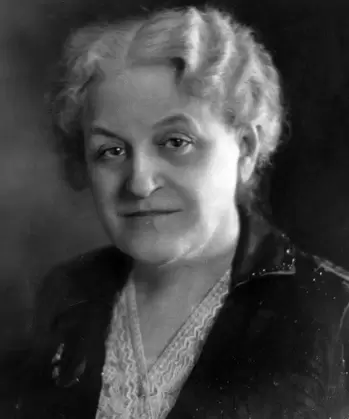 Carrie Chapman Catt, Britannica
Carrie Chapman Catt, Britannica
Doldrums:
But what did all of this education have to do with suffrage? Everything. One of the best anti-suffrage arguments was not granting women the vote would introduce yet another largely uneducated, potentially illiterate, group of people into the voting population. Remember it wasn’t too long ago, and was still within recent memory of most in power that men of color were also granted suffrage. How could women, who don’t work in industry, possibly vote in any informed way on issues of economics or politics? The growing numbers of women graduating with college degrees was proving that narrative false. Women can be informed voters.
Among the first wave of undergraduates with bachelor's degrees was Carrie Chapman Catt who was selected as the president of NAWSA, to succeed Susan B. Anthony. Catt was a formidable choice. She dedicated her entire life to suffrage. Her first husband died shortly after their marriage from typhoid fever, and she married her second husband, who she knew from college at Iowa State. In 1887, after a short career as a legal clerk and teacher, she joined the women’s crusade. George Catt supported his wife. He viewed their gendered roles as this: his job was to provide, hers was to improve the world. They never had kids and after he died, she worked alongside her female housemate and partner, Mary Garret Hay, for the cause of women. Many many years later, when she died, she chose to be buried under a loving inscription next to Hay.
From 1900 to 1904, Catt led NAWSA, but at the end of her tenure, her husband, Susan B Anthony, and her mother all passed away leaving Catt grief stricken. Without her at the helm, NAWSA struggled. Anna Howard Shaw, who held a degree in ministry and a doctoral degree in medicine, took charge. Shaw was a fierce advocate for working class women, but not a champion for all women. She frequently spoke about nativist views, championed white women’s causes, and created a hostile environment for African-Americans within the movement. But while hostile to some, Shaw is a striking example of the importance of suffrage to queer women. After all, queer women often did not have a man providing for them and all the privileges wives had did not necessarily extend to them. Shaw, like many suffragists, lived with a longtime female partner, Lucy Elmina Anthony, the niece of Susan B. Anthony. There was no man to provide for them, so women in these partnerships lived on the often pitiful and discriminatory salaries granted to women.
All over the country they led marches and were successful in getting some states to grant women the right to vote. California gave women the right to vote in 1911 and Tye Leung Schulze made history as the first Chinese-American woman, if not the first Asian woman in the world, to vote in a democratic election. Of the event she said, “I thought long over that. I studied; I read about all your men who wished to be president. I learned about the new laws. I wanted to KNOW what was right, not to act blindly...I think it is right we should all try to learn, not vote blindly, since we have been given this right to say which man we think is the greatest...I think too that we women are more careful than the men. We want to do our whole duty more. I do not think it is just the newness that makes use like that. It is conscience.”
Across the country, women in eastern states battled against long standing traditions and well-established patriarchal norms. Under Shaw’s leadership women’s suffrage stalled out. They’d been going state by state for decades working to get change and in those decades only nine states had granted women the right to vote: 70 years nine states. Something had to give and the women knew it. Perhaps the strategy was wrong? Between women suffragists, great debate broke out. There were the old-school NAWSA women who advocated for the tried and true continued effort in the state to state campaigns. State campaigns were growing and more and more women were joining the movement at the local level. But a young, animated, and educated generation of women were joining the movement.
But what did all of this education have to do with suffrage? Everything. One of the best anti-suffrage arguments was not granting women the vote would introduce yet another largely uneducated, potentially illiterate, group of people into the voting population. Remember it wasn’t too long ago, and was still within recent memory of most in power that men of color were also granted suffrage. How could women, who don’t work in industry, possibly vote in any informed way on issues of economics or politics? The growing numbers of women graduating with college degrees was proving that narrative false. Women can be informed voters.
Among the first wave of undergraduates with bachelor's degrees was Carrie Chapman Catt who was selected as the president of NAWSA, to succeed Susan B. Anthony. Catt was a formidable choice. She dedicated her entire life to suffrage. Her first husband died shortly after their marriage from typhoid fever, and she married her second husband, who she knew from college at Iowa State. In 1887, after a short career as a legal clerk and teacher, she joined the women’s crusade. George Catt supported his wife. He viewed their gendered roles as this: his job was to provide, hers was to improve the world. They never had kids and after he died, she worked alongside her female housemate and partner, Mary Garret Hay, for the cause of women. Many many years later, when she died, she chose to be buried under a loving inscription next to Hay.
From 1900 to 1904, Catt led NAWSA, but at the end of her tenure, her husband, Susan B Anthony, and her mother all passed away leaving Catt grief stricken. Without her at the helm, NAWSA struggled. Anna Howard Shaw, who held a degree in ministry and a doctoral degree in medicine, took charge. Shaw was a fierce advocate for working class women, but not a champion for all women. She frequently spoke about nativist views, championed white women’s causes, and created a hostile environment for African-Americans within the movement. But while hostile to some, Shaw is a striking example of the importance of suffrage to queer women. After all, queer women often did not have a man providing for them and all the privileges wives had did not necessarily extend to them. Shaw, like many suffragists, lived with a longtime female partner, Lucy Elmina Anthony, the niece of Susan B. Anthony. There was no man to provide for them, so women in these partnerships lived on the often pitiful and discriminatory salaries granted to women.
All over the country they led marches and were successful in getting some states to grant women the right to vote. California gave women the right to vote in 1911 and Tye Leung Schulze made history as the first Chinese-American woman, if not the first Asian woman in the world, to vote in a democratic election. Of the event she said, “I thought long over that. I studied; I read about all your men who wished to be president. I learned about the new laws. I wanted to KNOW what was right, not to act blindly...I think it is right we should all try to learn, not vote blindly, since we have been given this right to say which man we think is the greatest...I think too that we women are more careful than the men. We want to do our whole duty more. I do not think it is just the newness that makes use like that. It is conscience.”
Across the country, women in eastern states battled against long standing traditions and well-established patriarchal norms. Under Shaw’s leadership women’s suffrage stalled out. They’d been going state by state for decades working to get change and in those decades only nine states had granted women the right to vote: 70 years nine states. Something had to give and the women knew it. Perhaps the strategy was wrong? Between women suffragists, great debate broke out. There were the old-school NAWSA women who advocated for the tried and true continued effort in the state to state campaigns. State campaigns were growing and more and more women were joining the movement at the local level. But a young, animated, and educated generation of women were joining the movement.
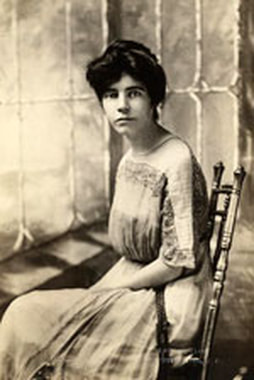 Alice Paul, Library of Congress
Alice Paul, Library of Congress
Paul and Burns:
Two of the most notable women in this group were Lucy Burns and Alice Paul. Both of these women not only had college degrees, but had multiple college degrees. Burns studied at Vassar College and Yale University and later at the University of Berlin in Germany and Oxford College abroad. There, Burns witnessed the militancy of the British suffrage movement.
In 1909 she joined Emmeline and Christabel Pankhurst's Women's Social and Political Union (WSPU) where she became an expert orator, and was arrested on numerous occasions. She met Alice Paul in a London police station after both were arrested during a suffrage demonstration outside Parliament.
Paul graduated with a degree in biology from Swarthmore College (1905), and earned graduate degrees in sociology at the University of Pennsylvania (M.A., 1907; Ph.D., 1912). Years after suffrage she would also earn two law degrees.
When they came home from England in 1910, Paul and Burns were disheartened at the state of women’s suffrage in the United States. They pressed NAWSA to take harder positions on suffrage and advocate for a federal amendment. The leaders in NAWSA gave Paul control over the Congressional Committee whose job was to press for a Federal Amendment to the constitution, not just a state by state approach. Between 1912 and 1913, Paul and Burns worked to organize the congressional committee and build it into a robust political force.
Baldwin:
Another one of these women was Marie Louise Bottineau Baldwin—a Chippewa. Baldwin had been born on Ojibwe land but was educated in American society and went on to become the first Indigenous woman to graduate from the Washington College of Law in Washington D.C. Despite this, she was an outspoken advocate of Indigenous communities and also a suffragette. In fact, on the day of her graduation from law school, Baldwin was asked by a reporter if she considered herself a suffragette; in response, she laughed and stated: “Did you ever know that the Indian women were among the first suffragists and that they exercised the right of recall?” In chiding the reporter, Baldwin highlights the fact that Indigenous women—especially those from matrilineal communities—often held and exercised political power amongst their peoples. Still, as demonstrated by her track record as a suffragette, Baldwin clearly believed that women more broadly deserved the right to vote.
Two of the most notable women in this group were Lucy Burns and Alice Paul. Both of these women not only had college degrees, but had multiple college degrees. Burns studied at Vassar College and Yale University and later at the University of Berlin in Germany and Oxford College abroad. There, Burns witnessed the militancy of the British suffrage movement.
In 1909 she joined Emmeline and Christabel Pankhurst's Women's Social and Political Union (WSPU) where she became an expert orator, and was arrested on numerous occasions. She met Alice Paul in a London police station after both were arrested during a suffrage demonstration outside Parliament.
Paul graduated with a degree in biology from Swarthmore College (1905), and earned graduate degrees in sociology at the University of Pennsylvania (M.A., 1907; Ph.D., 1912). Years after suffrage she would also earn two law degrees.
When they came home from England in 1910, Paul and Burns were disheartened at the state of women’s suffrage in the United States. They pressed NAWSA to take harder positions on suffrage and advocate for a federal amendment. The leaders in NAWSA gave Paul control over the Congressional Committee whose job was to press for a Federal Amendment to the constitution, not just a state by state approach. Between 1912 and 1913, Paul and Burns worked to organize the congressional committee and build it into a robust political force.
Baldwin:
Another one of these women was Marie Louise Bottineau Baldwin—a Chippewa. Baldwin had been born on Ojibwe land but was educated in American society and went on to become the first Indigenous woman to graduate from the Washington College of Law in Washington D.C. Despite this, she was an outspoken advocate of Indigenous communities and also a suffragette. In fact, on the day of her graduation from law school, Baldwin was asked by a reporter if she considered herself a suffragette; in response, she laughed and stated: “Did you ever know that the Indian women were among the first suffragists and that they exercised the right of recall?” In chiding the reporter, Baldwin highlights the fact that Indigenous women—especially those from matrilineal communities—often held and exercised political power amongst their peoples. Still, as demonstrated by her track record as a suffragette, Baldwin clearly believed that women more broadly deserved the right to vote.
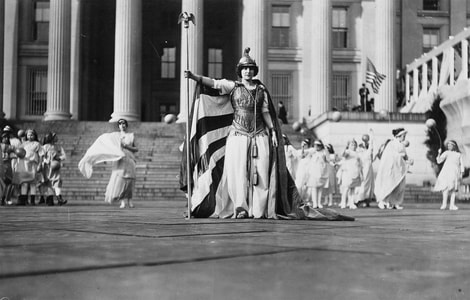 Woman at the Women's Suffrage Parade, The Atlantic
Woman at the Women's Suffrage Parade, The Atlantic
Suffrage Parade:
On March 3, 1913, they held a women’s suffrage parade in Washington DC the day before Woodrow Wilson’s inauguration. Paul has begun planning this since well before she was even granted a title in the women’s movement. Her planning was meticulous, she tapped every resource and connection she had in DC and in the Taft administration that was exiting, and her expert use of public relations kept suffrage and the parade in the media so frequently that people associated the parade with Wilson’s inauguration. Women were led down Pennsylvania Avenue by Inez Milholland atop a horse representing Columbia, a symbol of the United States. Following her women were grouped by alma mater demonstrating their expertise and education levels, women were then grouped by state showing that women in every state wanted the right to vote, women were also grouped by profession with various industries given somatic outfits to wear, showing the depth of the suffrage movement and how intersected so many women’s lives.
Baldwin also marched in the National Woman Suffrage Procession, though on her own terms. At first, the parade’s organizers had apparently asked her to create a float that paid tribute to Indigenous women quite broadly. Baldwin, however, refused to homogenize Indigenous women into a monolithic, stereotypical figure. Instead, she chose to march as a “modern Indigenous woman” and joined the ranks of other attorneys likely from the North Carolina delegation.
Planning for the parade was not, however, perfect. Paul had many factions within the suffrage movement to appease and made concessions to Southern suffragists at the expense of Black suffragists. Black leaders like Ida B Wells Barnett as well as Delta Sigma Theta, a black sorority from nearby Howard University, were left off of the program, and told that they could march in the back. Constrained by all the demands thrown at her, Paul said, “As far as I can see, we must have a white procession, or a Negro procession, or no procession at all.”
On March 3, 1913, they held a women’s suffrage parade in Washington DC the day before Woodrow Wilson’s inauguration. Paul has begun planning this since well before she was even granted a title in the women’s movement. Her planning was meticulous, she tapped every resource and connection she had in DC and in the Taft administration that was exiting, and her expert use of public relations kept suffrage and the parade in the media so frequently that people associated the parade with Wilson’s inauguration. Women were led down Pennsylvania Avenue by Inez Milholland atop a horse representing Columbia, a symbol of the United States. Following her women were grouped by alma mater demonstrating their expertise and education levels, women were then grouped by state showing that women in every state wanted the right to vote, women were also grouped by profession with various industries given somatic outfits to wear, showing the depth of the suffrage movement and how intersected so many women’s lives.
Baldwin also marched in the National Woman Suffrage Procession, though on her own terms. At first, the parade’s organizers had apparently asked her to create a float that paid tribute to Indigenous women quite broadly. Baldwin, however, refused to homogenize Indigenous women into a monolithic, stereotypical figure. Instead, she chose to march as a “modern Indigenous woman” and joined the ranks of other attorneys likely from the North Carolina delegation.
Planning for the parade was not, however, perfect. Paul had many factions within the suffrage movement to appease and made concessions to Southern suffragists at the expense of Black suffragists. Black leaders like Ida B Wells Barnett as well as Delta Sigma Theta, a black sorority from nearby Howard University, were left off of the program, and told that they could march in the back. Constrained by all the demands thrown at her, Paul said, “As far as I can see, we must have a white procession, or a Negro procession, or no procession at all.”
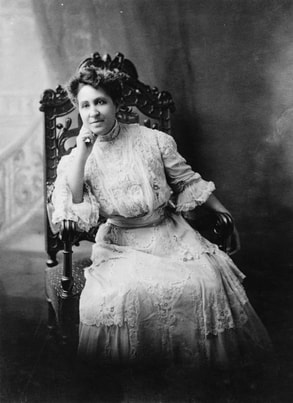 Mary Church Terrell, Wikimedia Commons
Mary Church Terrell, Wikimedia Commons
After being told that they would have to march in the back, Wells addressed the marchers the night before. Full of tears and trembling, she stated, “if they did not take a stand now in this great democratic parade then the colored women are lost.” Grace Trout, the leader of the Illinois contingent to which Wells belonged, sided with Paul and the segregationists. Wells left the room vowing not to march at all.
Of course, she would march. Wells stood on the sideline as the march began the next morning. And when the Illinois delegation walked past her, she calmly and collectively stepped into the street and joined them. This was a women's march, not a white women’s march. And women were going to get the right to vote together, not parceled off by race and class.
Mary Church Terrell, founder of the National Association of Colored Women marched with the all-Black delegation at the back. She later stated that she believed Paul and other white suffrage leaders would sacrifice Black women in order to get white women the vote. Paul of course denied that, but didn’t stop catering to racists within the movement.
Of course, she would march. Wells stood on the sideline as the march began the next morning. And when the Illinois delegation walked past her, she calmly and collectively stepped into the street and joined them. This was a women's march, not a white women’s march. And women were going to get the right to vote together, not parceled off by race and class.
Mary Church Terrell, founder of the National Association of Colored Women marched with the all-Black delegation at the back. She later stated that she believed Paul and other white suffrage leaders would sacrifice Black women in order to get white women the vote. Paul of course denied that, but didn’t stop catering to racists within the movement.
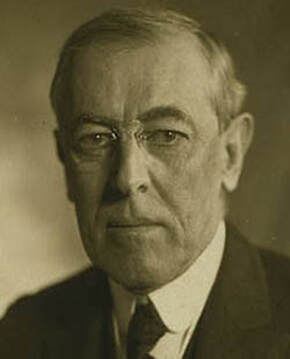 Woodrow Wilson, Library of Congress
Woodrow Wilson, Library of Congress
As the marchers made their way down Pennsylvania Avenue things seemed to be going well. Paul had planned ahead because the DC police had threatened not to protect her and asked for a regiment to be standing by. Thankfully she had.
What started as jeers from the crowd turned into a riot. Over 100 people ended up in the hospital as the DC police abandoned their positions along the parade route and let misogynists attack the women on the street. Newspapers blamed the DC police. Women’s suffrage was on the front page! Woodrow Wilson, the new president, was not the top story. If he wanted to have a successful presidency, women’s suffrage would have to pass.
1916 Election:
But Woodrow Wilson was not easy to break. While he said he supported women’s suffrage, he didn’t think that it was politically possible to pass it. We should also mention that he was formerly the president of Princeton, one of the Ivy League schools that didn’t support women getting degrees. Wilson came to suffrage events and gave speeches where he supported their work, but refused to take a policy position on it. So when he was up for reelection, Paul and Burns refused to endorse him.
What started as jeers from the crowd turned into a riot. Over 100 people ended up in the hospital as the DC police abandoned their positions along the parade route and let misogynists attack the women on the street. Newspapers blamed the DC police. Women’s suffrage was on the front page! Woodrow Wilson, the new president, was not the top story. If he wanted to have a successful presidency, women’s suffrage would have to pass.
1916 Election:
But Woodrow Wilson was not easy to break. While he said he supported women’s suffrage, he didn’t think that it was politically possible to pass it. We should also mention that he was formerly the president of Princeton, one of the Ivy League schools that didn’t support women getting degrees. Wilson came to suffrage events and gave speeches where he supported their work, but refused to take a policy position on it. So when he was up for reelection, Paul and Burns refused to endorse him.
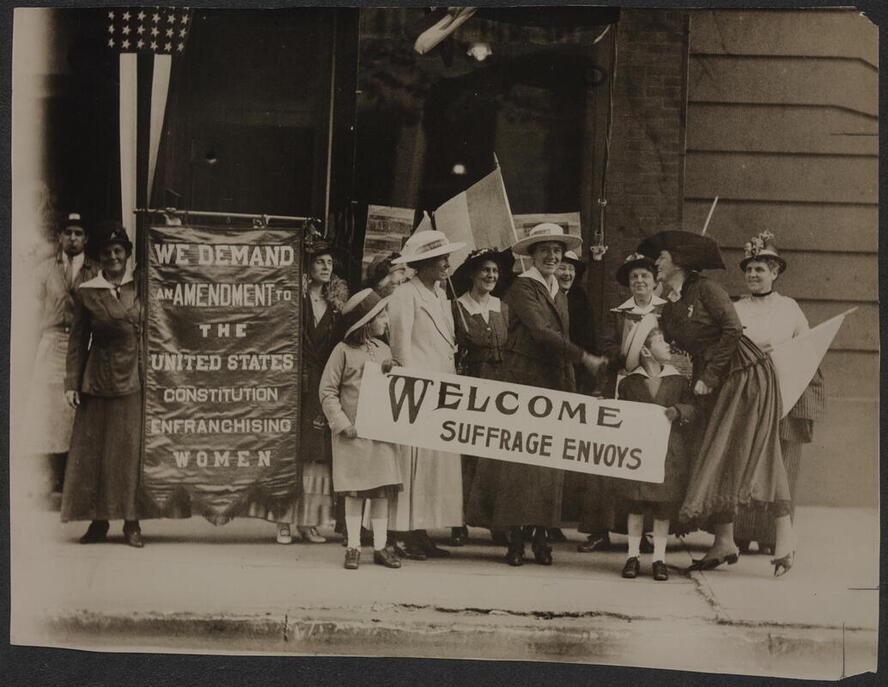 National Women's Party, Library of Congress
National Women's Party, Library of Congress
The suffrage parade was not all good for women’s suffrage. Paul and Burns his true colors were beginning to show and their radical tactics for achieving women’s suffrage were not supported by other women in the movement. By February 1914 Paul and Burns were ousted from NAWSA and all of the funds they had raised for the congressional committee stripped from them. They rebranded as the National Women’s Party, a rival organization with more aggressive and radical positions than Shaw’s NAWSA.
As suffrage was fracturing and dividing over tactics, Carrie Chapman Catt returned to steer NAWSA through its final push for suffrage. In 1915, she returned as president of NAWSA. Catt proposed her “Winning Plan” which compromised between the factions to simultaneously fight for suffrage at the state and federal levels. She also received a 1 million dollar bequest from New York City magazine editor and publisher Miriam Folline Leslie “for the cause of woman suffrage.”
During the election year, the NWP traveled state to state to urge people to vote against Wilson and instead endorse a candidate who would support women’s suffrage… though none emerged. Wilson and his Republican opponent Charles Evan Hughes endorsed the state by state approach to women’s suffrage. Paul met with Hughes on behalf of her members and women who could vote in various, mostly western states. After the meeting she was disappointed, she said:
“Voting women will not accept a mere endorsement of the principle of suffrage. They are solely interested in the best method of protecting their own political rights and of emancipating the rest of their sex. The Republican Party wants the women’s votes. They are essential to the success of the party next fall. But it will not receive them by default.”
As suffrage was fracturing and dividing over tactics, Carrie Chapman Catt returned to steer NAWSA through its final push for suffrage. In 1915, she returned as president of NAWSA. Catt proposed her “Winning Plan” which compromised between the factions to simultaneously fight for suffrage at the state and federal levels. She also received a 1 million dollar bequest from New York City magazine editor and publisher Miriam Folline Leslie “for the cause of woman suffrage.”
During the election year, the NWP traveled state to state to urge people to vote against Wilson and instead endorse a candidate who would support women’s suffrage… though none emerged. Wilson and his Republican opponent Charles Evan Hughes endorsed the state by state approach to women’s suffrage. Paul met with Hughes on behalf of her members and women who could vote in various, mostly western states. After the meeting she was disappointed, she said:
“Voting women will not accept a mere endorsement of the principle of suffrage. They are solely interested in the best method of protecting their own political rights and of emancipating the rest of their sex. The Republican Party wants the women’s votes. They are essential to the success of the party next fall. But it will not receive them by default.”
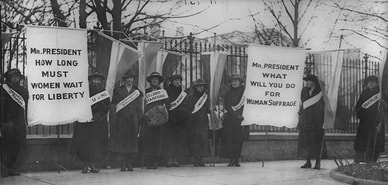 Silent Sentinels Outside the White House, Wikimedia Commons
Silent Sentinels Outside the White House, Wikimedia Commons
The fact that a presidential candidate met with her, just shows how powerful politicking had become.
The NWP was narrowly focused, willing to endorse whichever candidate would support national suffrage. NAWSA on the other hand, backed Woodrow Wilson because of his continued effort to keep America out of World War I. Wilson won the election and within a month took the United States to war. For women on both issues, the reelection of Woodrow Wilson was a disappointment. Like in the Civil War decades before, many women became engrossed in the war movement. They served as nurses, within the new branch of the Marines for women, rolling bandages, volunteering, building victory gardens, and whatever needed to be done to support the country in war.
Silent Sentinels:
But unlike most women, the National Women’s Party did not relent. Starting on January 10, 1917, the women’s party began sending “silent sentinels” as they were referred to, to picket outside of the White House and keep relentless pressure on Woodrow Wilson to pass the amendment. They held "watchfires," where they burned copies of Wilson's speeches, and called him a hypocrite. They picketed six days a week, rain or shine. When the United States joined the war effort, what little support they had from onlookers in DC diminished. The suffragists were seen as unpatriotic, belittling a president while he was at war. For many, the president’s focus should have been solely on bringing American boys home, but Paul and Burns did not back down, they doubled down. They pointed out the hypocrisy of fighting for democracy abroad while American women could not fight at home. Insultingly, they used Wilson’s words against him:
The NWP was narrowly focused, willing to endorse whichever candidate would support national suffrage. NAWSA on the other hand, backed Woodrow Wilson because of his continued effort to keep America out of World War I. Wilson won the election and within a month took the United States to war. For women on both issues, the reelection of Woodrow Wilson was a disappointment. Like in the Civil War decades before, many women became engrossed in the war movement. They served as nurses, within the new branch of the Marines for women, rolling bandages, volunteering, building victory gardens, and whatever needed to be done to support the country in war.
Silent Sentinels:
But unlike most women, the National Women’s Party did not relent. Starting on January 10, 1917, the women’s party began sending “silent sentinels” as they were referred to, to picket outside of the White House and keep relentless pressure on Woodrow Wilson to pass the amendment. They held "watchfires," where they burned copies of Wilson's speeches, and called him a hypocrite. They picketed six days a week, rain or shine. When the United States joined the war effort, what little support they had from onlookers in DC diminished. The suffragists were seen as unpatriotic, belittling a president while he was at war. For many, the president’s focus should have been solely on bringing American boys home, but Paul and Burns did not back down, they doubled down. They pointed out the hypocrisy of fighting for democracy abroad while American women could not fight at home. Insultingly, they used Wilson’s words against him:
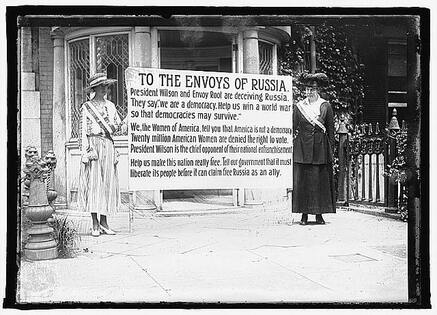 Women Protesting, Teaching American History
Women Protesting, Teaching American History
“WE SHALL FIGHT FOR THE THINGS WE HAVE ALWAYS HELD NEAREST TO OUR HEARTS.”
When the United States’ ally, Russia sent a delegation to meet with Wilson and discuss their mutual role in preserving democracy, Lucy Burns and Dora Lewis held a banner that read:
“We, the Women of America, tell you that America is not a democracy. Twenty million American Women are denied the right to vote. President Wilson is the chief opponent of their national enfranchisement.”
For mothers the connection between war and suffrage was obvious: the president was drafting their sons to go to war and they had no say in it. For many women suffrage became a symbol of anti-war sentiments.
But things eventually became tense. As women picketed outside the White House, onlookers became increasingly hostile and agitated. Soldiers harassed the women. In June of 1917, police tried to confiscate the women’s banner, which obviously violated free-speech. Women resisted. They were arrested. Eventually the government came up with a scheme to charge them with blocking traffic because they were attracting so much attention. The women argued their case in court claiming that they were “political prisoners.“ And that they were arrested because they disagreed with the ruling political party. Arrested day after day, at least 150 different women were imprisoned during this period. They refused to pay their fines and were taken to the Occoquan Workhouse prison in Virginia to work off their debts. Once released, they would be back out on the picket line the next day.
When the United States’ ally, Russia sent a delegation to meet with Wilson and discuss their mutual role in preserving democracy, Lucy Burns and Dora Lewis held a banner that read:
“We, the Women of America, tell you that America is not a democracy. Twenty million American Women are denied the right to vote. President Wilson is the chief opponent of their national enfranchisement.”
For mothers the connection between war and suffrage was obvious: the president was drafting their sons to go to war and they had no say in it. For many women suffrage became a symbol of anti-war sentiments.
But things eventually became tense. As women picketed outside the White House, onlookers became increasingly hostile and agitated. Soldiers harassed the women. In June of 1917, police tried to confiscate the women’s banner, which obviously violated free-speech. Women resisted. They were arrested. Eventually the government came up with a scheme to charge them with blocking traffic because they were attracting so much attention. The women argued their case in court claiming that they were “political prisoners.“ And that they were arrested because they disagreed with the ruling political party. Arrested day after day, at least 150 different women were imprisoned during this period. They refused to pay their fines and were taken to the Occoquan Workhouse prison in Virginia to work off their debts. Once released, they would be back out on the picket line the next day.
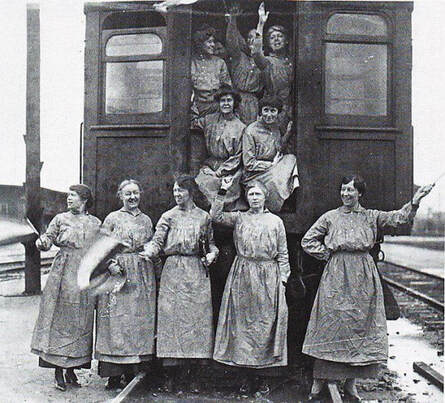 Suffragettes at Occoquan Workhouse, Richmond Public Library
Suffragettes at Occoquan Workhouse, Richmond Public Library
Night of Terror and Hunger Strike:
Resistance to suffragists became violent and hostile. Paul and Burns were also arrested. Paul was sentenced to 7 months in Occoquan in October 1917. She began a hunger strike. The prison guards responded by force feeding her: forcing a tube down her throat and dropping raw eggs into her mouth twice a day. Then they tried to say she was insane and took her to a psychiatric hospital. The superintendent, William Alanson White, refused to admit her, stating that she was "perfectly calm, yet determined."
Outside the prison, suffragists rallied behind her. Many went to picket the White House for suffrage and also picket on behalf of Paul.
Resistance to suffragists became violent and hostile. Paul and Burns were also arrested. Paul was sentenced to 7 months in Occoquan in October 1917. She began a hunger strike. The prison guards responded by force feeding her: forcing a tube down her throat and dropping raw eggs into her mouth twice a day. Then they tried to say she was insane and took her to a psychiatric hospital. The superintendent, William Alanson White, refused to admit her, stating that she was "perfectly calm, yet determined."
Outside the prison, suffragists rallied behind her. Many went to picket the White House for suffrage and also picket on behalf of Paul.
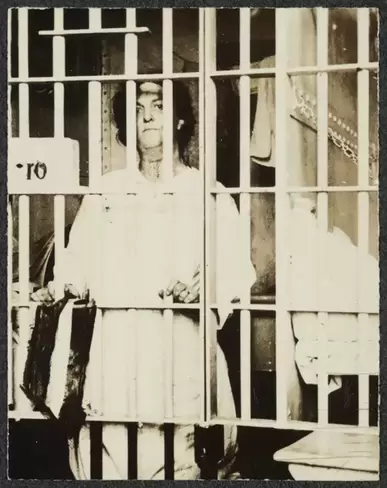 Suffragette Helena Hill in Jail, NPS.Gov
Suffragette Helena Hill in Jail, NPS.Gov
On November 14, 1917, 33 suffragists from the NWP were brutally beaten and tortured by 40 male prison guards, to “teach them a lesson.” This night went down in history as the “Night of Terror.” Testimony shared in a later investigation proved that the suffragists were dragged, beaten, choked, slammed, pinched, and kicked. Dora Lewis' arm was twisted behind her back. They twice slammed her into an iron bed where she fell unconscious and bleeding. Alice Cosu thought Lewis was dead and the panic caused her to suffer a heart attack. She was denied medical treatment until the next morning. Burns tried to check in with everyone and make sure they were ok. She started a roll call, which led her to be identified as the leader. The guards handcuffed her arms to the cell bars above her head, leaving her bleeding on tiptoe until they took her down. Burns and the other suffragists went on hunger strike for three days following the Night of Terror. Burns was removed and taken to a different prison where she too was force-fed by putting a tube through her nostril, a process that caused horrible nose bleeds. Burns spent more time in prison than other American suffragists. While all of this was going on, it was not public knowledge. The press had yet to find out this information, and American support of the NWP remained low.
Dudley Field Malone, worked as an attorney and campaign adviser to Wilson. He resigned to represent the Silent Sentinels in court. He also took letters that the suffragist had written in prison and secretly released them to the NWP newspaper, The Suffragist. The night of terror, Paul and Burns’s treatment, and the unjust arrests of the picketers was major news across the country And helped bring support for the suffrage cause. Not only did he help get all of the women released from prison, he also had their wrongful arrests overturned by the unanimous vote. Malone would go on to marry Doris Stevens, an important and active silent sentinel imprisoned at Occoquan.
Dudley Field Malone, worked as an attorney and campaign adviser to Wilson. He resigned to represent the Silent Sentinels in court. He also took letters that the suffragist had written in prison and secretly released them to the NWP newspaper, The Suffragist. The night of terror, Paul and Burns’s treatment, and the unjust arrests of the picketers was major news across the country And helped bring support for the suffrage cause. Not only did he help get all of the women released from prison, he also had their wrongful arrests overturned by the unanimous vote. Malone would go on to marry Doris Stevens, an important and active silent sentinel imprisoned at Occoquan.
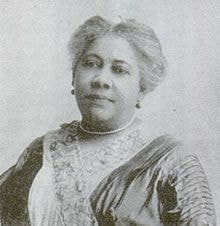 Mary B. Talbet, Wikimedia Commons
Mary B. Talbet, Wikimedia Commons
Paul wrote: "Seems almost unthinkable now, doesn't it? It was shocking that a government of men could look with such extreme contempt on a movement that was asking nothing except such a simple little thing as the right to vote."
African American Women:
Meanwhile, NAWSA was busy fighting for Catt’s Winning Plan. Catt’s leadership secured several key states: New York, Michigan, Oklahoma, and South Dakota in 1917 and 1918. Catt was winning in one respect and losing in another. She consistently catered to racists within the movement.
Mary B. Talbert was a member of the NACW and NAACP. In 1915 she wrote in The Crisis, “with us as colored women, this struggle becomes two-fold, first, because we are women and second, because we are colored women.”
African American Women:
Meanwhile, NAWSA was busy fighting for Catt’s Winning Plan. Catt’s leadership secured several key states: New York, Michigan, Oklahoma, and South Dakota in 1917 and 1918. Catt was winning in one respect and losing in another. She consistently catered to racists within the movement.
Mary B. Talbert was a member of the NACW and NAACP. In 1915 she wrote in The Crisis, “with us as colored women, this struggle becomes two-fold, first, because we are women and second, because we are colored women.”
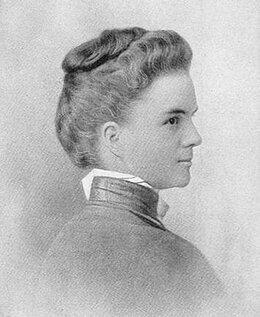 Adella Logan Hunt, Wikimedia Commons
Adella Logan Hunt, Wikimedia Commons
Black women were often belittled in how they might use the vote. Nannie Helen Burroughs aptly retorted, “What can she do without it?” Burroughs and other Black women made clear that Black women “needs the ballot, to reckon with men who place no value upon her virtue, and to mould [sic] healthy sentiment in favor of her own protection.”
Adella Hunt Logan concurred, adding: “If white American women, with all their natural and acquired advantages, need the ballot, that right protective of all other rights; if Anglo Saxons have been helped by it... how much more do black Americans, male and female need the strong defense of a vote to help secure them their right to life, liberty and the pursuit of happiness?”
Racism, discrimination, and racial violence forced Black women toward civil rights activism, in addition to suffrage. Perhaps overly optimistic, Angelina Weld Grimké, the great niece of abolitionist and suffragist Angelina Grimké Weld, stated, “injustices will end [between the sexes when woman] gains the ballot.”
Adella Hunt Logan concurred, adding: “If white American women, with all their natural and acquired advantages, need the ballot, that right protective of all other rights; if Anglo Saxons have been helped by it... how much more do black Americans, male and female need the strong defense of a vote to help secure them their right to life, liberty and the pursuit of happiness?”
Racism, discrimination, and racial violence forced Black women toward civil rights activism, in addition to suffrage. Perhaps overly optimistic, Angelina Weld Grimké, the great niece of abolitionist and suffragist Angelina Grimké Weld, stated, “injustices will end [between the sexes when woman] gains the ballot.”
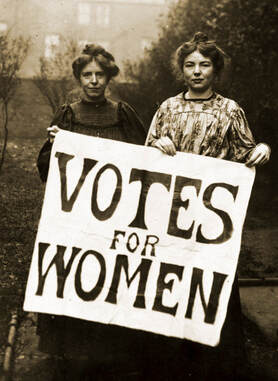 Suffragettes, Wikimedia Commons
Suffragettes, Wikimedia Commons
Ratification:
Then finally, in 1918, Wilson put the weight of his presidency behind the cause of suffrage and supported a national constitutional amendment. But why the sudden change of heart? Was it the public pressure from the torture of Paul and Burns? Or was it pragmatic given how many states Catt was able to secure? We may never know. Wilson claimed he was not swayed by the “radicals” in the NWP, and stated that the amendment's purpose was to help win World War I.
The amendment passed Congress the next year on August 26, 1920. It thus began a long ratification process.
Ratification in Tennessee:
To ratify an amendment to the Constitution, it needs to be approved by three quarters of the states— a very high bar. Suffragists at the state level fought to have the amendment ratified. It took a year, but finally the 36th state came to ratify the amendment: Tennessee.
Then finally, in 1918, Wilson put the weight of his presidency behind the cause of suffrage and supported a national constitutional amendment. But why the sudden change of heart? Was it the public pressure from the torture of Paul and Burns? Or was it pragmatic given how many states Catt was able to secure? We may never know. Wilson claimed he was not swayed by the “radicals” in the NWP, and stated that the amendment's purpose was to help win World War I.
The amendment passed Congress the next year on August 26, 1920. It thus began a long ratification process.
Ratification in Tennessee:
To ratify an amendment to the Constitution, it needs to be approved by three quarters of the states— a very high bar. Suffragists at the state level fought to have the amendment ratified. It took a year, but finally the 36th state came to ratify the amendment: Tennessee.
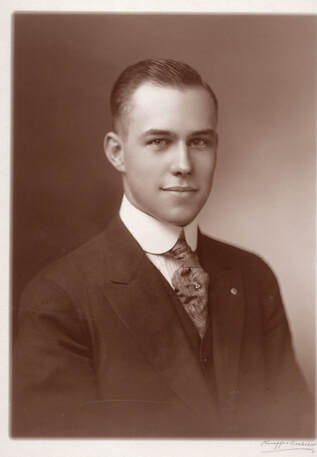 Harry T. Burns, Wikimedia Commons
Harry T. Burns, Wikimedia Commons
Tennessee was the last possible hope that the Amendment would get ratified. Like elsewhere in the country, the all male legislature met to discuss the Amendment and, yet again, debate women’s status as citizens. Harry T. Burn was one of these state representatives. He supported suffrage, but the men in his district did not. Debate in Tennessee raged on in what became known as the War of the Roses. Pro-suffrage legislators wore yellow roses, while anti-suffragists wore red. There were accounts of bribery, negotiations, and lots of drinking. Legislators would be seen wearing a yellow flower one day and a red one the next.
In this context Febb Burn, Harry’s mom wrote him a letter. She said, “Hurrah, and vote for suffrage, and don’t keep them in doubt… Don’t forget to be a good boy and help Mrs. ‘Thomas Catt’ with her ‘rats.’ Is she the one that put rat in ratification? Ha! No more from Mama this time. With lots of love.”
Her son, wearing the red anti-suffrage flower, and with his mothers letter in his pocket, dramatically changed his vote in favor of suffrage. Pandemonium followed.
In this context Febb Burn, Harry’s mom wrote him a letter. She said, “Hurrah, and vote for suffrage, and don’t keep them in doubt… Don’t forget to be a good boy and help Mrs. ‘Thomas Catt’ with her ‘rats.’ Is she the one that put rat in ratification? Ha! No more from Mama this time. With lots of love.”
Her son, wearing the red anti-suffrage flower, and with his mothers letter in his pocket, dramatically changed his vote in favor of suffrage. Pandemonium followed.
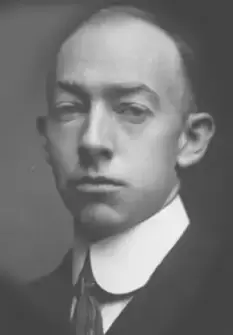 Banks Turner, Wikimedia Commons
Banks Turner, Wikimedia Commons
When things calmed, the roll call resumed. Anti-suffragists appeared to be winning. Then, after sitting silently through his turn, Banks Turner broke his silence as the antis were clearly winning and cast a vote: “Mr. Speaker, I wish to be recorded as voting Aye.”
Women’s suffrage passed by ONE vote at the very last second. The chamber was in uproar, but the vote was won.
By the end of this era, so much remained in question. What would happen for these newly enfranchised women? Would there emerge a women’s voting block? Would women of color be granted full access to the vote, or would they too be subjected to discrimination at the polls? How long would it take for noncitizens, Chinese and indigenous women to gain the vote? What would the next battles for women’s liberation look like?
Women’s suffrage passed by ONE vote at the very last second. The chamber was in uproar, but the vote was won.
By the end of this era, so much remained in question. What would happen for these newly enfranchised women? Would there emerge a women’s voting block? Would women of color be granted full access to the vote, or would they too be subjected to discrimination at the polls? How long would it take for noncitizens, Chinese and indigenous women to gain the vote? What would the next battles for women’s liberation look like?
Draw your own conclusions
|
Learn how to teach with inquiry.
Many of these lesson plans were sponsored in part by the Library of Congress Teaching with Primary Sources Eastern Region Program, coordinated by Waynesburg University, the History and Social Studies Education Faculty at Plymouth State University, and the Patrons of the Remedial Herstory Project. |
Lesson Plans from Other Organizations
- The National Women's History Museum has lesson plans on women's history.
- The Guilder Lehrman Institute for American History has lesson plans on women's history.
- The NY Historical Society has articles and classroom activities for teaching women's history.
- Unladylike 2020, in partnership with PBS, has primary sources to explore with students and outstanding videos on women from the Progressive era.
- The Roy Rosenzweig Center for History and New Media has produced recommendations for teaching women's history with primary sources and provided a collection of sources for world history. Check them out!
- The Stanford History Education Group has a number of lesson plans about women in US History.
Period Specific Lesson Plans from Other Organizations
- Stanford History Education Group: The 19th Amendment was passed seventy-two years after the Seneca Falls Convention. This fact demonstrates the strong opposition that women’s suffrage faced. In this lesson, students study a speech and anti-suffrage literature to explore the reasons why so many Americans, including many women, opposed women's suffrage.
- C3 Teachers: This inquiry leads students through an investigation of voting rights in America. By investigating the compelling question “Was the vote enough?” students evaluate both sides of the early twentieth century quest to expand suffrage to women. The formative performance tasks build on knowledge and skills through the course of the inquiry and help students determine if getting the vote was enough to give women full social and political equality. Students create an evidence-based argument about whether or not the vote is enough.
- C3 Teachrs: This inquiry examines the emergence of the women’s suffrage movement in the 19th century as an effort to expand women’s political and economic rights, and it extends that investigation into the present. The compelling question “What does it mean to be equal?” provides students with an opportunity to examine the nature of equality and the changing conditions for women in American society from the 19th century to today. Each supporting question begins by asking about 19th-century women’s rights and then asks about contemporary gender equality. The relationship between women’s rights and gender equality is a central focus of this inquiry. Students begin the inquiry by exploring the legal limits placed on women in the 19th century and how efforts to gain rights were undertaken by women at the Seneca Falls Convention.
- C3 Teachers: This inquiry leads students through an investigation of the women’s suffrage movement in New York State as an example of how different groups of people have gained equal rights and freedoms over time. Through examining the role women played in society before the 20th century and the efforts made by women to gain the right to vote, students will be prepared to develop arguments supported by evidence that answer the compelling question “What did it take for women to be considered ‘equal’ to men in New York?” Subsequent inquiries could be developed around other groups who have struggled to gain rights and freedoms, including, but not limited to, Native Americans and African Americans.
- Gilder Lehrman: Over the course of two lessons, students will analyze primary source documents in order to examine the factors that contributed to the exclusion of American women from the right to vote and the battle for full enfranchisement. They will read and interpret complex documents, engage in discussions, and, in order to demonstrate comprehension, answer critical thinking questions.
- National Women’s History Museum: Was the woman suffrage movement inclusive? This lesson seeks to explore the role of Black women in the Women’s Suffrage Movement and their exclusion from the generally accepted Women’s Suffrage narrative. Students will examine primary and secondary sources to explore some of the unsung heroes of the Women’s Suffrage Movement and the contributions of these unsung heroes to the movement. As a summative assessment, students will create an exhibit detailing the contributions of a Black Suffragist.
- Gilder Lehrman: The American women’s suffrage movement has always been identified with its two founders, Elizabeth Cady Stanton and Susan B. Anthony, whose strong, enthusiastic leadership defined the movement. When they retired from active participation in the cause, the loss of that personal connection naturally affected the movement’s future. The transition was not an easy one. As the National American Woman Suffrage Association (NAWSA), the organization that Stanton and Anthony had led, headed into the twentieth century, it lost the dynamism and direction of the nineteenth-century association. Successors had difficulty measuring up to Stanton and Anthony, and the organization was unable to develop a focused plan for its difficult campaign. Alice Paul joined the fray in 1910. Did she pick up where Stanton and Anthony left off? The answer to that question is not obvious. Almost anyone familiar with the suffrage movement has a notion of Stanton and Anthony’s leadership, but most people know far less about Alice Paul, whose contributions are not often remembered in the movement’s history. Investigation into Paul’s life and contributions reveals that she had a very different approach to the battle for the vote; that she was a radical compared to the NAWSA leaders who succeeded Stanton and Anthony; and that she devoted her life to winning the passage of the Nineteenth Amendment and, later, to the effort to secure the enactment of the Equal Rights Amendment. Any history of the women’s suffrage movement that fails to take into account Alice Paul and her organization, the National Woman’s Party, is incomplete. Using the classroom as a historical laboratory, students can use primary and secondary sources to research the history of Alice Paul, her associates, and the NWP. The students can be historians; they can discover the history of Alice Paul and her fight for women’s suffrage.
- Edcitement: An article originally published in the 1991 Session Weekly of the Minnesota House of Representatives recalls the arguments put forth in objection to the Minnesota Equal Suffrage Association's decision, early in the 20th century, to push for the right of women to vote in presidential elections. One lawmaker declared that all-male voting was "designed by our forefathers." Later, Rep. Thomas Girling argued that "women shouldn't be dragged into the dirty pool of politics." Approving such a measure, he said, would "cause irreparable damage at great expense to the state." When the Senate took up the bill, one member asserted that "disaster and ruin would overtake the nation." Suffrage would lead inevitably to "government by females" because "men could never resist the blandishments of women." Instead, he recommended that women "attach themselves to some man who will represent them in public affairs." Though such arguments may now sound rather ridiculous to some, they are closely related to entrenched views of women that took more than a century to overcome (assuming one agrees they have been overcome). Understanding the positions of the suffrage and anti-suffrage movements—as expressed in archival broadsides, speeches, pamphlets, and political cartoons—will help your students better appreciate the struggle for women's rights and the vestiges of the anti-suffrage positions that lasted at least through the 1960s and, perhaps, to the present day.
- PBS and DPLA: This collection uses primary sources to explore the campaign for women's suffrage through the passage of the Nineteenth Amendment. Digital Public Library of America Primary Source Sets are designed to help students develop their critical thinking skills and draw diverse material from libraries, archives, and museums across the United States. Each set includes an overview, ten to fifteen primary sources, links to related resources, and a teaching guide. These sets were created and reviewed by the teachers on the DPLA's Education Advisory Committee.
- National History Day: Ida B. Wells (1862-1931) was born to slave parents in Holly Springs, Mississippi, on July 16, 1862, two months before President Abraham Lincoln issued the Emancipation Proclamation. As a young girl, Wells watched her parents work as political activists during Reconstruction. In 1878, tragedy struck as Wells lost both of her parents and a younger brother in a yellow fever epidemic. To support her younger siblings, Wells became a teacher, eventually moving to Memphis, Tennessee. In 1884, Wells found herself in the middle of a heated lawsuit. After purchasing a first-class train ticket, Wells was ordered to move to a segregated car. She refused to give up her seat and was forcibly removed from the train. Wells filed suit against the railroad and won. This victory was short lived, however, as the Tennessee Supreme Court overturned the lower court ruling in 1887. In 1892, Wells became editor and co-owner of The Memphis Free Speech and Headlight. Here, she used her skills as a journalist to champion the causes for African American and women’s rights. Among her most known works were those on behalf of anti-lynching legislation. Until her death in 1931, Ida B. Wells dedicated her life to what she referred to as a “crusade for justice.”
- Unladylike: Learn about Mary Church Terrell, daughter of former slaves and one of the first African American women to earn both a Bachelor and a Master’s degree, who became a national leader for civil rights and women’s suffrage, in this video from Unladylike2020. Terrell was one of the earliest anti-lynching advocates and joined the suffrage movement, focusing her life’s work on racial uplift—the belief that blacks would end racial discrimination and advance themselves through education, work, and community activism. She helped found the National Association of Colored Women (NACW) and the National Association for the Advancement of Colored People (NAACP). Support materials include discussion questions and teaching tips for research projects. Primary source analysis activities emphasize how the content connects to racial justice issues that continue today, including a close reading of the Emmett Till Antilynching Bill of 2020. Sensitive: This resource contains material that may be sensitive for some students. Teachers should exercise discretion in evaluating whether this resource is suitable for their class.
Suffragettes and Racism
Sojourner Truth: Aint I a Woman
Truth was an escaped slave and consistent women’s rights advocate. She gave voice to the feelings of many Black women that they were abandoned by both Black and women’s groups—when the issues each addressed both had adverse effects on her.
”Well, children, where there is so much racket there must be something out of kilter. I think that 'twixt the negroes of the South and the women at the North, all talking about rights, the white men will be in a fix pretty soon. But what's all this here talking about?
That man over there says that women need to be helped into carriages, and lifted over ditches, and to have the best place everywhere. Nobody ever helps me into carriages, or over mud-puddles, or gives me any best place! And ain't I a woman? Look at me! Look at my arm! I have ploughed and planted, and gathered into barns, and no man could head me! And ain't I a woman? I could work as much and eat as much as a man - when I could get it - and bear the lash as well! And ain't I a woman? I have borne thirteen children, and seen most all sold off to slavery, and when I cried out with my mother's grief, none but Jesus heard me! And ain't I a woman?
Then they talk about this thing in the head; what's this they call it? [member of audience whispers, "intellect"] That's it, honey. What's that got to do with women's rights or negroes' rights? If my cup won't hold but a pint, and yours holds a quart, wouldn't you be mean not to let me have my little half measure full?
Then that little man in black there, he says women can't have as much rights as men, 'cause Christ wasn't a woman! Where did your Christ come from? Where did your Christ come from? From God and a woman! Man had nothing to do with Him.
If the first woman God ever made was strong enough to turn the world upside down all alone, these women together ought to be able to turn it back , and get it right side up again! And now they is asking to do it, the men better let them.
Obliged to you for hearing me, and now old Sojourner ain't got nothing more to say.
Truth, Sojourner. "Ain't I a Woman?” Women's Convention, Akron, Ohio. December, 1851. Retrieved from https://sourcebooks.fordham.edu/mod/sojtruth-woman.asp.
”Well, children, where there is so much racket there must be something out of kilter. I think that 'twixt the negroes of the South and the women at the North, all talking about rights, the white men will be in a fix pretty soon. But what's all this here talking about?
That man over there says that women need to be helped into carriages, and lifted over ditches, and to have the best place everywhere. Nobody ever helps me into carriages, or over mud-puddles, or gives me any best place! And ain't I a woman? Look at me! Look at my arm! I have ploughed and planted, and gathered into barns, and no man could head me! And ain't I a woman? I could work as much and eat as much as a man - when I could get it - and bear the lash as well! And ain't I a woman? I have borne thirteen children, and seen most all sold off to slavery, and when I cried out with my mother's grief, none but Jesus heard me! And ain't I a woman?
Then they talk about this thing in the head; what's this they call it? [member of audience whispers, "intellect"] That's it, honey. What's that got to do with women's rights or negroes' rights? If my cup won't hold but a pint, and yours holds a quart, wouldn't you be mean not to let me have my little half measure full?
Then that little man in black there, he says women can't have as much rights as men, 'cause Christ wasn't a woman! Where did your Christ come from? Where did your Christ come from? From God and a woman! Man had nothing to do with Him.
If the first woman God ever made was strong enough to turn the world upside down all alone, these women together ought to be able to turn it back , and get it right side up again! And now they is asking to do it, the men better let them.
Obliged to you for hearing me, and now old Sojourner ain't got nothing more to say.
Truth, Sojourner. "Ain't I a Woman?” Women's Convention, Akron, Ohio. December, 1851. Retrieved from https://sourcebooks.fordham.edu/mod/sojtruth-woman.asp.
Susan B Anthony: The Revolution
Anthony was a founding member of NWSA and of NAWSA. She was furious at the possibility that all men would get the vote and not also all women, a concept called universal suffrage. She stated she would cut off her arm before working for Negro rights before women’s rights. In 1869, Anthony defended her position in favor of woman suffrage in her suffrage newspaper The Revolution.
The Revolution criticizes, ‘opposes’ the fifteenth amendment, not for what it is, but for what it is not. Not because it enfranchises black men, but because it does not enfranchise all women, black and white. It is not the little good it proposes, but the greater evil it perpetuates that we deprecate. It is not that in the abstract we do not rejoice that black men are to become equals of white men, but that we deplore the fact that two million (sic) black women, hitherto the political and social equals of the men by their side, are to become subjects, slaves of these men. Our protest is not that all men are lifted out of the degradation of disfranchisement, but that all women are left in. The Revolution and the National Women’s Suffrage Association make women’s suffrage their test of loyalty, not Negro suffrage, not Maine law or prohibition. Do you believe women should vote? Is the one and only question in our catechism.
Anthony, Susan B. The Revolution. October 7, 1869. Retrieved from Susan B. Anthony Birthplace Museum. http://www.susanbanthonybirthplace.com/racism.html.
The Revolution criticizes, ‘opposes’ the fifteenth amendment, not for what it is, but for what it is not. Not because it enfranchises black men, but because it does not enfranchise all women, black and white. It is not the little good it proposes, but the greater evil it perpetuates that we deprecate. It is not that in the abstract we do not rejoice that black men are to become equals of white men, but that we deplore the fact that two million (sic) black women, hitherto the political and social equals of the men by their side, are to become subjects, slaves of these men. Our protest is not that all men are lifted out of the degradation of disfranchisement, but that all women are left in. The Revolution and the National Women’s Suffrage Association make women’s suffrage their test of loyalty, not Negro suffrage, not Maine law or prohibition. Do you believe women should vote? Is the one and only question in our catechism.
Anthony, Susan B. The Revolution. October 7, 1869. Retrieved from Susan B. Anthony Birthplace Museum. http://www.susanbanthonybirthplace.com/racism.html.
Susan B. Anthony: to Booker T. Washington
This letter was written by Anthony to Booker T. Washington, the founder of the Tuskeegee Institute, who, along with his wife, Margaret Murray, educated free men and women in industrial work, among other initiatives. Anthony was a founding member of NWSA and of NAWSA.
N.Y. [City] Jan. 23, 1900
My Dear Friend: I received yours of the 16th. Certainly whenever I go to Atlanta again, it is my intention to visit Tuskegee. I am, however, hoping that my time of going will be postponed to next Autumn, when the legislatures of several of the Southern States will be in session. I think then would be a much better time for us to be in the South, and to speak perchance before every one of the legislatures, and thus send at least a representative from every district in the state, home to his constituents with a little idea of what this woman's rights movement means.
It is one of my dreams to visit Tuskegee, and to see you and Mrs. Washington and Mrs. [Adella Hunt] Logan, and all of the good men and women engaged in the splendid work of that institute. Wishing you the best of success, I am, Very sincerely yours,
Susan B. Anthony
Anthony, Susan B. “Letter from Susan Brownell Anthony to Booker T. Washington.” New York City. January, 23 1900. The Booker T. Washington Papers, Library of Congress. Published in Louis R. Harlan and Raymond W. Smock, eds., The Booker T. Washington Papers. Urbana: University of Illinois Press, 1976, 5:419. Retrieved from http://www.nzdl.org.
N.Y. [City] Jan. 23, 1900
My Dear Friend: I received yours of the 16th. Certainly whenever I go to Atlanta again, it is my intention to visit Tuskegee. I am, however, hoping that my time of going will be postponed to next Autumn, when the legislatures of several of the Southern States will be in session. I think then would be a much better time for us to be in the South, and to speak perchance before every one of the legislatures, and thus send at least a representative from every district in the state, home to his constituents with a little idea of what this woman's rights movement means.
It is one of my dreams to visit Tuskegee, and to see you and Mrs. Washington and Mrs. [Adella Hunt] Logan, and all of the good men and women engaged in the splendid work of that institute. Wishing you the best of success, I am, Very sincerely yours,
Susan B. Anthony
Anthony, Susan B. “Letter from Susan Brownell Anthony to Booker T. Washington.” New York City. January, 23 1900. The Booker T. Washington Papers, Library of Congress. Published in Louis R. Harlan and Raymond W. Smock, eds., The Booker T. Washington Papers. Urbana: University of Illinois Press, 1976, 5:419. Retrieved from http://www.nzdl.org.
Elizabeth Cady Stanton: Manhood Suffrage
During the debates over the 15th Amendment, Stanton published these comments in the suffrage newspaper The Revolution. Some historians have argued that she was attempting to use male logic against them. Stanton was a founding member of NWSA and later NAWSA.
“Think of Patrick and Sambo [derogatory, meaning mixed-race] and Hans and Yung Tung who do not know the difference between a Monarchy and a Republic, who never read the Declaration of Independence or Webster’s spelling book, making laws for Lydia Maria Child, Lucretia Mott or Fanny Kemble. Think of jurors drawn from these ranks to try young girls for the crime of infanticide.”
Stanton, Elizabeth Cady. “Manhood Suffrage.” The Revolution. Retrieved from Susan B. Anthony Birthplace Museum. http://www.susanbanthonybirthplace.com/racism.html.
“Think of Patrick and Sambo [derogatory, meaning mixed-race] and Hans and Yung Tung who do not know the difference between a Monarchy and a Republic, who never read the Declaration of Independence or Webster’s spelling book, making laws for Lydia Maria Child, Lucretia Mott or Fanny Kemble. Think of jurors drawn from these ranks to try young girls for the crime of infanticide.”
Stanton, Elizabeth Cady. “Manhood Suffrage.” The Revolution. Retrieved from Susan B. Anthony Birthplace Museum. http://www.susanbanthonybirthplace.com/racism.html.
Frances Ellen Watkins Harper: Speech at Women's Rights Convention
Frances Ellen Watkins Harper was an active abolitionist made famous in the North for her abolition speeches and open letter to John Brown. This speech comes from the Eleventh National Women’s Rights Convention in New York City in May of 1866.
I feel I am something of a novice upon this platform. Born of a race whose inheritance has been outrage and wrong, most of my life had been spent in battling against those wrongs. But I did not feel as keenly as others, that I had these rights, in common with other women, which are now demanded. About two years ago, I stood within the shadows of my home. A great sorrow had fallen upon my life. My husband had died suddenly, leaving me a widow, with four children, one my own, and the others stepchildren. I tried to keep my children together. But my husband died in debt; and before he had been in his grave three months, the administrator had swept the very milk-crocks and wash tubs from my hands. I was a farmer’s wife and made butter for the Columbus market; but what could I do, when they had swept all away? They left me one thing-and that was a looking glass! Had I died instead of my husband, how different would have been the result! By this time he would have had another wife, it is likely; and no administrator would have gone into his house, broken up his home, and sold his bed, and taken away his means of support…
I do not believe that giving the woman the ballot is immediately going to cure all the ills of life. I do not believe that white women are dew-drops just exhaled from the skies. I think that like men they may be divided into three classes, the good, the bad, and the indifferent. The good would vote according to their convictions and principles; the bad, as dictated by preju[d]ice or malice; and the indifferent will vote on the strongest side of the question, with the winning party.
You white women speak here of rights. I speak of wrongs. I, as a colored woman, have had in this country an education which has made me feel… against every man, and every man’s hand against me. Let me go to-morrow morning and take my seat in one of your street cars-I do not know that they will do it in New York, but they will in Philadelphia-and the conductor will put up his hand and stop the car rather than let me ride… Have women nothing to do with this?...
Talk of giving women the ballot-box? Go on. It is a normal school, and the white women of this country need it. While there exists this brutal element in society which tramples upon the feeble and treads down the weak, I tell you that if there is any class of people who need to be lifted out of their airy nothings and selfishness, it is the white women of America.
Harper, Frances Ellen Watkins. “We Are All Bound Up Together”. 1866. BlackPast. November 7, 2011. Retrieved from https://www.blackpast.org/african-american-history/speeches-african-american-history/1866-frances-ellen-watkins-harper-we-are-all-bound-together/.
I feel I am something of a novice upon this platform. Born of a race whose inheritance has been outrage and wrong, most of my life had been spent in battling against those wrongs. But I did not feel as keenly as others, that I had these rights, in common with other women, which are now demanded. About two years ago, I stood within the shadows of my home. A great sorrow had fallen upon my life. My husband had died suddenly, leaving me a widow, with four children, one my own, and the others stepchildren. I tried to keep my children together. But my husband died in debt; and before he had been in his grave three months, the administrator had swept the very milk-crocks and wash tubs from my hands. I was a farmer’s wife and made butter for the Columbus market; but what could I do, when they had swept all away? They left me one thing-and that was a looking glass! Had I died instead of my husband, how different would have been the result! By this time he would have had another wife, it is likely; and no administrator would have gone into his house, broken up his home, and sold his bed, and taken away his means of support…
I do not believe that giving the woman the ballot is immediately going to cure all the ills of life. I do not believe that white women are dew-drops just exhaled from the skies. I think that like men they may be divided into three classes, the good, the bad, and the indifferent. The good would vote according to their convictions and principles; the bad, as dictated by preju[d]ice or malice; and the indifferent will vote on the strongest side of the question, with the winning party.
You white women speak here of rights. I speak of wrongs. I, as a colored woman, have had in this country an education which has made me feel… against every man, and every man’s hand against me. Let me go to-morrow morning and take my seat in one of your street cars-I do not know that they will do it in New York, but they will in Philadelphia-and the conductor will put up his hand and stop the car rather than let me ride… Have women nothing to do with this?...
Talk of giving women the ballot-box? Go on. It is a normal school, and the white women of this country need it. While there exists this brutal element in society which tramples upon the feeble and treads down the weak, I tell you that if there is any class of people who need to be lifted out of their airy nothings and selfishness, it is the white women of America.
Harper, Frances Ellen Watkins. “We Are All Bound Up Together”. 1866. BlackPast. November 7, 2011. Retrieved from https://www.blackpast.org/african-american-history/speeches-african-american-history/1866-frances-ellen-watkins-harper-we-are-all-bound-together/.
Kate Gordon: to Roberta Wellford
Gordon was a leading member of NAWSA and head of the Southern Suffrage Association. She advocated for educated suffrage, but also white-women’s suffrage as a means for promoting white supremacy over Black men. This is a letter she wrote in 1916.
January 11, 1916.
Miss Roberta Wellford,
University of Va., P.O., Virginia.
My dear Miss Wellford:
…if woman suffrage is kept as a state right, you will see that the negro women will not get any special national protection such as they can get, with a mandate forbidding disfranchisement on account of sex. In reality every prohibition against the negro man’s voting could be applied to the women, but in the states where their numbers make them a menace the subterfuges that are employed are really illegal, and the mass of the men who are determined to preserve white supremacy are willing, if it is necessary, to club negro men away from the polls, but you will understand a sympathy with them when they do not wish to be forced to club negro women, and the women hearing this are far more belligerent!
I feel that if the franchise comes to the women of the south through the state and that we can continue the present restrictions there will be no trouble for the negro women, but if by any chance the national amendment does carry I think there will be trouble for them, and much of the good that we women want to see come from suffrage will be defeated by entangling it with this race prejudice. That is why I think out southern women endorsing a nationalamendment are making a serious mistake.
I do not know much about the publication of the CRISIS. It stands for negro uplift, but so far as I can make out that negro uplift is an effort in behalf of negro equality. We take the CRISIS simply to be in touch and prepare to answer southern editors, and frequently we have written letters to editors and I believe with good results. If you would like to see some of these copies of the paper I will be glad to send them to you. This summer they had a “Votes for Women” edition with Abraham Lincoln and Sojourner Truth as the frontispiece, and it makes the prejudiced southerners not over zealous for woman suffrage at their best, foam at the mouth.
We are commencing to get comments on Mrs. Patty Jacobs’ statistics in her Congressional speech. I wish to the Lord the woman suffragists would try to fight shy of the race question instead of courting it by national endorsement. Of course, her enthusiastic support is the aftermath of the Shafroth amendment activity. Just think of the fatal work that fool thing has accomplished and the opportunity and time wasted, not to mention the money spent in its advocacy.
I hope that you are studying out with care the United States Elections Bill. A copy of it appears in the January issue of the NEW SOUTHERN CITIZEN. If the Democratic Party is awake to its opportunity it will pass it and spike the Republicans‘ chance for doing so, when they get in power, which very probably they will in the next administration.
Very cordially,
Kate M. Gordon
January 11, 1916.
Miss Roberta Wellford,
University of Va., P.O., Virginia.
My dear Miss Wellford:
…if woman suffrage is kept as a state right, you will see that the negro women will not get any special national protection such as they can get, with a mandate forbidding disfranchisement on account of sex. In reality every prohibition against the negro man’s voting could be applied to the women, but in the states where their numbers make them a menace the subterfuges that are employed are really illegal, and the mass of the men who are determined to preserve white supremacy are willing, if it is necessary, to club negro men away from the polls, but you will understand a sympathy with them when they do not wish to be forced to club negro women, and the women hearing this are far more belligerent!
I feel that if the franchise comes to the women of the south through the state and that we can continue the present restrictions there will be no trouble for the negro women, but if by any chance the national amendment does carry I think there will be trouble for them, and much of the good that we women want to see come from suffrage will be defeated by entangling it with this race prejudice. That is why I think out southern women endorsing a nationalamendment are making a serious mistake.
I do not know much about the publication of the CRISIS. It stands for negro uplift, but so far as I can make out that negro uplift is an effort in behalf of negro equality. We take the CRISIS simply to be in touch and prepare to answer southern editors, and frequently we have written letters to editors and I believe with good results. If you would like to see some of these copies of the paper I will be glad to send them to you. This summer they had a “Votes for Women” edition with Abraham Lincoln and Sojourner Truth as the frontispiece, and it makes the prejudiced southerners not over zealous for woman suffrage at their best, foam at the mouth.
We are commencing to get comments on Mrs. Patty Jacobs’ statistics in her Congressional speech. I wish to the Lord the woman suffragists would try to fight shy of the race question instead of courting it by national endorsement. Of course, her enthusiastic support is the aftermath of the Shafroth amendment activity. Just think of the fatal work that fool thing has accomplished and the opportunity and time wasted, not to mention the money spent in its advocacy.
I hope that you are studying out with care the United States Elections Bill. A copy of it appears in the January issue of the NEW SOUTHERN CITIZEN. If the Democratic Party is awake to its opportunity it will pass it and spike the Republicans‘ chance for doing so, when they get in power, which very probably they will in the next administration.
Very cordially,
Kate M. Gordon
Native Women, Citizenship and Suffrage
Congress: Elk v. Wilkins, 112 U.S. 94 (1884)
In Elk v. Wilkins, 112 U.S. 94 (1884), the Court found that acquisition of U.S. citizenship at birth under the Constitution if born within the United States did not extend to children of Native American tribes, holding that they were not "subject to the jurisdiction of the United States" at birth.
"[The Fourteenth Amendment] contemplates two sources of citizenship, and two sources only: birth and naturalization. The persons declared to be citizens are 'all persons born or naturalized in the United States, and subject to the jurisdiction thereof.' The evident meaning of these last words is, not merely subject in some respect or degree to the jurisdiction of the United States, but completely subject to their political jurisdiction, and owing them direct and immediate allegiance. And the words relate to the time of birth in the one case, as they do to the time of naturalization in the other. Persons not thus subject to the jurisdiction of the United States at the time of birth cannot become so afterwards, except by being naturalized, either individually, as by proceedings under the naturalization acts; or collectively, as by the force of a treaty by which foreign territory is acquired. Indians born within the territorial limits of the United States, members of, and owing immediate allegiance to, one of the Indian tribes (an alien though dependent power,) although in a geographical sense born in the United States, are no more 'born in the United States and subject to the jurisdiction thereof,' within the meaning of the first section of the Fourteenth Amendment, than the children of subjects of any foreign government born within the domain of that government, or the children born within the United States, of ambassadors or other public ministers of foreign nations."
U.S. Department of State Foreign Affairs Manual. Supreme Court Decisions. Elk v. Wilkins, 112 U.S. 94. 1884. https://fam.state.gov/fam/08fam/08fam010203.html
According to the 14th Amendment and the opinion in Elk v. Wilkins, why were native people denied citizenship?
"[The Fourteenth Amendment] contemplates two sources of citizenship, and two sources only: birth and naturalization. The persons declared to be citizens are 'all persons born or naturalized in the United States, and subject to the jurisdiction thereof.' The evident meaning of these last words is, not merely subject in some respect or degree to the jurisdiction of the United States, but completely subject to their political jurisdiction, and owing them direct and immediate allegiance. And the words relate to the time of birth in the one case, as they do to the time of naturalization in the other. Persons not thus subject to the jurisdiction of the United States at the time of birth cannot become so afterwards, except by being naturalized, either individually, as by proceedings under the naturalization acts; or collectively, as by the force of a treaty by which foreign territory is acquired. Indians born within the territorial limits of the United States, members of, and owing immediate allegiance to, one of the Indian tribes (an alien though dependent power,) although in a geographical sense born in the United States, are no more 'born in the United States and subject to the jurisdiction thereof,' within the meaning of the first section of the Fourteenth Amendment, than the children of subjects of any foreign government born within the domain of that government, or the children born within the United States, of ambassadors or other public ministers of foreign nations."
U.S. Department of State Foreign Affairs Manual. Supreme Court Decisions. Elk v. Wilkins, 112 U.S. 94. 1884. https://fam.state.gov/fam/08fam/08fam010203.html
According to the 14th Amendment and the opinion in Elk v. Wilkins, why were native people denied citizenship?
Marie Louise Bottineau Baldwin: Excerpt
Marie Baldwin, a Chippewa Native, was among the first to earn a law degree in the United States. She was later appointed to the Bureau of Indian affairs, before she could even vote. She dedicated her life to improving the conditions of Native peoples.
Did you ever know that the Indian women were among the first suffragists, and that they exercised the right of recall? The trouble in this Indian question which I meet again and again is
that it is not the Indian who needs to be educated so constantly up to the white man, but that the white man needs to be educated to the Indian. Many, indeed, are the things which the paleface does not know about his red brother. Without reference or question, the attitude of tho earlier settlers has been handed down from generation to generation, as matter of course, and the
mistakes that they made are still discernible in the efforts of their descendants…
To go back to the suffragists and the right of recall. The popular idea of the Indian woman is that she was a beast of burden, with nothing but work ahead of and behind her. That she ever had a hand in the government is almost unknown. But she did, and it was a strong one. It. is true that she did most of the work, but merely because It happened to be a more natural arrangement of affairs. The brave was constantly prepared for a war. and If you have any idea that It Is an easy thing to go out and get three meals a day from the uncultivated fields and thin air just try it yourself. The Indian woman was Indeed the power behind the throne. It has been the case In many instances that the women did not like the maneuvers of the chief. What did they do? They got together and told their plans to the braves. Insisted upon a recall and & new chief and they got one. They suggested, knew and talked over the affairs of state, with their men folks, and there
was very little doing Indeed of which they were ever unaware…
There are so few of us left that It behooves us to lay aside all feeling against one another and the paleface, and make remnants' or a once mighty race, worthy of the land in which they now live.”
The Washington times. [volume] (Washington [D.C.]), 03 Aug. 1914. Chronicling America: Historic American Newspapers. Lib. of Congress. https://chroniclingamerica.loc.gov/lccn/sn84026749/1914-08-03/ed-1/seq-9/.
What was her main argument for woman suffrage and native citizenship?
Did you ever know that the Indian women were among the first suffragists, and that they exercised the right of recall? The trouble in this Indian question which I meet again and again is
that it is not the Indian who needs to be educated so constantly up to the white man, but that the white man needs to be educated to the Indian. Many, indeed, are the things which the paleface does not know about his red brother. Without reference or question, the attitude of tho earlier settlers has been handed down from generation to generation, as matter of course, and the
mistakes that they made are still discernible in the efforts of their descendants…
To go back to the suffragists and the right of recall. The popular idea of the Indian woman is that she was a beast of burden, with nothing but work ahead of and behind her. That she ever had a hand in the government is almost unknown. But she did, and it was a strong one. It. is true that she did most of the work, but merely because It happened to be a more natural arrangement of affairs. The brave was constantly prepared for a war. and If you have any idea that It Is an easy thing to go out and get three meals a day from the uncultivated fields and thin air just try it yourself. The Indian woman was Indeed the power behind the throne. It has been the case In many instances that the women did not like the maneuvers of the chief. What did they do? They got together and told their plans to the braves. Insisted upon a recall and & new chief and they got one. They suggested, knew and talked over the affairs of state, with their men folks, and there
was very little doing Indeed of which they were ever unaware…
There are so few of us left that It behooves us to lay aside all feeling against one another and the paleface, and make remnants' or a once mighty race, worthy of the land in which they now live.”
The Washington times. [volume] (Washington [D.C.]), 03 Aug. 1914. Chronicling America: Historic American Newspapers. Lib. of Congress. https://chroniclingamerica.loc.gov/lccn/sn84026749/1914-08-03/ed-1/seq-9/.
What was her main argument for woman suffrage and native citizenship?
Wilhelmina Kekelaokalaninui Widemann Dowsett: Memoir
Until the 1890s, Hawaii was ruled by an indigenous Hawaiian monarchy. It’s final queen, Queen Liliʻuokalani was overthrown by businessmen and landowners descended from American missionaries. Hawaii was annexed by the United States in 1898. Queen Liliuokalani traveled to DC to protest annexation. Other native Hawaiians like Wilhelmina Kekelaokalaninui Widemann Dowsett, took a more pragmatic approach and argued that they should have the right to suffrage since they had it in Hawaii. Dowsett founded the National Women’s Equal Suffrage Association and hosted meetings in her home. Hawaiian women became enfranchised with the 19th Amendment, but as residents of a U.S. territory, their representation was limited until Hawaii became a state on August 21, 1959.
Sister Hawaiians, our foreign sisters are with us. Senator Wise asked us yesterday if the so-called ‘society women’ were leading us, and we told him that this was not so. We are working all together, and we want the legislature to know this. And we must also remember our Oriental sisters, who are not here today but who will also unite this great cause.
National Park Service. “Wilhelmina Kekelaokalaninui Widemann Dowsett.” https://www.nps.gov/people/wilhelmina-kekelaokalaninui-widemann-dowsett.htm.
What was her main argument for woman suffrage and native citizenship?
Sister Hawaiians, our foreign sisters are with us. Senator Wise asked us yesterday if the so-called ‘society women’ were leading us, and we told him that this was not so. We are working all together, and we want the legislature to know this. And we must also remember our Oriental sisters, who are not here today but who will also unite this great cause.
National Park Service. “Wilhelmina Kekelaokalaninui Widemann Dowsett.” https://www.nps.gov/people/wilhelmina-kekelaokalaninui-widemann-dowsett.htm.
What was her main argument for woman suffrage and native citizenship?
Zitkala-Sa: Life
Zitkala-Ša grew up in boarding schools designed to strip native children of their indigenous cultures. There she adopted the name Gertrude Simmons Bonnin, which she later abandoned. She was a Native American suffragist, writer and activist until her death in 1938. After women got the vote, Zitkala-Sa became an advocate for the Snyder Act of 1924 which granted full citizenship to Native Americans.
I remember my mother. I was born in a teepee. I loved that life. It was beautiful, more beautiful than I can tell you. But my mother said to me. “You must learn the white man’s language so when you grow up you will talk for us and for the Indian and the white man will have a better understanding.” I said…“I am going to do the best I can and then I am going to let the Great Spirit do the rest.” … Then I think I have forgotten the most important thing of all, and that is our Maker the Great Spirit. We must keep our faith in the Great Spirit because this applied to every day thinking in our homes and wherever we go.
Then let us have level heads. let us not cower. We are men and women with minds and hearts. Why, the Great Almighty made us! We are here like other human beings and there is no reason why we should be afraid to hold up our heads. Let us stand up straight. Let us study conditions; let us give reasons why. And if we fail at the first trial, shall we quit? No, we will try again. You believe in right—then stand for that… We must continue speaking and claiming our human rights to live on this earth that God has made, so that we may think our thoughts and speak them—that we may have our part in the American life and be as any other human beings are…
We are rational beings. Let us develop our powers by thinking and acting for ourselves. That is the way we grow… I have been in sessions of Congress when the great men there met together. They will discuss their subjects, some on one side, some on another, both giving soundest arguments. Was it treason for these men to have difference of opinions? It was not treason against the Government. They were representing their people, they were representing the Government, but they had different views and they had the privilege of speaking… We are in America, and we have, each one of us, a right to express our views. We agree on the main thing… We want the privilege of rational men for, were we idiots or lunatics we would not be here, we would be in some hospital or asylum. But, because we are rational creatures, we have a right to express our thoughts and to try to come to some plan, according to the best of our light. This is our policy.
Bonnin, Gertrude (Zitkala-Sa). “Address by Mrs. Gertrude Bonnin.” The American Indian, Vol. 7, No. 3 (1919). Delivered to the Annual Convention of the Society of American Indians. 2-4 October 1919.
What was her main argument for woman suffrage and native citizenship?
I remember my mother. I was born in a teepee. I loved that life. It was beautiful, more beautiful than I can tell you. But my mother said to me. “You must learn the white man’s language so when you grow up you will talk for us and for the Indian and the white man will have a better understanding.” I said…“I am going to do the best I can and then I am going to let the Great Spirit do the rest.” … Then I think I have forgotten the most important thing of all, and that is our Maker the Great Spirit. We must keep our faith in the Great Spirit because this applied to every day thinking in our homes and wherever we go.
Then let us have level heads. let us not cower. We are men and women with minds and hearts. Why, the Great Almighty made us! We are here like other human beings and there is no reason why we should be afraid to hold up our heads. Let us stand up straight. Let us study conditions; let us give reasons why. And if we fail at the first trial, shall we quit? No, we will try again. You believe in right—then stand for that… We must continue speaking and claiming our human rights to live on this earth that God has made, so that we may think our thoughts and speak them—that we may have our part in the American life and be as any other human beings are…
We are rational beings. Let us develop our powers by thinking and acting for ourselves. That is the way we grow… I have been in sessions of Congress when the great men there met together. They will discuss their subjects, some on one side, some on another, both giving soundest arguments. Was it treason for these men to have difference of opinions? It was not treason against the Government. They were representing their people, they were representing the Government, but they had different views and they had the privilege of speaking… We are in America, and we have, each one of us, a right to express our views. We agree on the main thing… We want the privilege of rational men for, were we idiots or lunatics we would not be here, we would be in some hospital or asylum. But, because we are rational creatures, we have a right to express our thoughts and to try to come to some plan, according to the best of our light. This is our policy.
Bonnin, Gertrude (Zitkala-Sa). “Address by Mrs. Gertrude Bonnin.” The American Indian, Vol. 7, No. 3 (1919). Delivered to the Annual Convention of the Society of American Indians. 2-4 October 1919.
What was her main argument for woman suffrage and native citizenship?
Matilda Gage: Excerpt
Gage was a white suffragist and an author alongside Susan B. Anthony and Elizabeth Cady Stanton of the dense History of Women’s Suffrage. She was also an advocate for Native rights and citizenship.
The famous Iroquois Indians, or Six Nations… showed alike in form of government, and in social life, reminiscences of the Matriarchate. The line of descent, feminine, was especially notable in all tribal relations such as the election of Chiefs, and the Council of Matrons, to which all disputed questions were referred for final adjudication. No sale of lands was valid without consent of the squaws… The women also possessed the veto power on questions of war… If for any cause the Iroquois husband and wife separated, the wife took with her all the property she had brought into the wigwam; the children also accompanied the mother, whose right to them was recognized as supreme… Not alone the Iroquois but most Indians of North America trace descent in the female line; among some tribes woman enjoys almost the whole legislative authority and in others a prominent share… Thus to the Matriarchate or Mother-rule is the modern world indebted for its first conception of inherent rights, natural equality of condition, and the establishment of a civilized government upon this basis. Although the reputation of the Iroquois as warriors appears most prominent in history, we nevertheless find their real principles to have been the true Matriarchal one of peace and industry. Driven from the northern portion of America by vindictive foes, compelled to take up arms in self-protection, yet the more peaceful occupations of hunting and agriculture were continually followed.
Gage, Matilda Josyln. Woman, Church & State. Project Gutenberg, 2014. Originally published in 1983. https://www.gutenberg.org/files/45580/45580-h/45580-h.htm.
The famous Iroquois Indians, or Six Nations… showed alike in form of government, and in social life, reminiscences of the Matriarchate. The line of descent, feminine, was especially notable in all tribal relations such as the election of Chiefs, and the Council of Matrons, to which all disputed questions were referred for final adjudication. No sale of lands was valid without consent of the squaws… The women also possessed the veto power on questions of war… If for any cause the Iroquois husband and wife separated, the wife took with her all the property she had brought into the wigwam; the children also accompanied the mother, whose right to them was recognized as supreme… Not alone the Iroquois but most Indians of North America trace descent in the female line; among some tribes woman enjoys almost the whole legislative authority and in others a prominent share… Thus to the Matriarchate or Mother-rule is the modern world indebted for its first conception of inherent rights, natural equality of condition, and the establishment of a civilized government upon this basis. Although the reputation of the Iroquois as warriors appears most prominent in history, we nevertheless find their real principles to have been the true Matriarchal one of peace and industry. Driven from the northern portion of America by vindictive foes, compelled to take up arms in self-protection, yet the more peaceful occupations of hunting and agriculture were continually followed.
Gage, Matilda Josyln. Woman, Church & State. Project Gutenberg, 2014. Originally published in 1983. https://www.gutenberg.org/files/45580/45580-h/45580-h.htm.
chinese Women, Citizenship and Suffrage
Congress: Chinese Exclusion Act
This act provided an absolute 10-year ban on Chinese laborers immigrating to the United States. When the exclusion act expired in 1892, Congress extended it for 10 years in the form of the Geary Act. This extension, made permanent in 1902, added restrictions by requiring each Chinese resident to register and obtain a certificate of residence. Without a certificate, they faced deportation. In 1943, when China was a member of the Allied Nations during World War II, Congress repealed all the exclusion acts, but the quotas remained. True reform did not come until the 1990s and the act was condemned by congress in 2011.
An Act to execute certain treaty stipulations relating to Chinese.
Whereas in the opinion of the Government of the United States the coming of Chinese laborers to this country endangers the good order of certain localities within the territory thereof: Therefore,
Be it enacted… That… after the passage of this act… it shall not be lawful for any Chinese laborer to come, or having so come after the expiration of said ninety days to remain within the United States.
…SEC. 12. That no Chinese person shall be permitted to enter the United States by land without producing to the proper officer of customs the certificate in this act required of Chinese persons seeking to land from a vessel…
SEC. 14. That hereafter no State court or court of the United States shall admit Chinese to citizenship; and all laws in conflict with this act are hereby repealed…
Approved, May 6, 1882.
An act to execute certain treaty stipulations relating to the Chinese, May 6, 1882; Enrolled Acts and Resolutions of Congress, 1789-1996; General Records of the United States Government; Record Group 11; National Archives.
Women and the Chinese community are left “Out in the cold” in this 1884 magazine cover.
An Act to execute certain treaty stipulations relating to Chinese.
Whereas in the opinion of the Government of the United States the coming of Chinese laborers to this country endangers the good order of certain localities within the territory thereof: Therefore,
Be it enacted… That… after the passage of this act… it shall not be lawful for any Chinese laborer to come, or having so come after the expiration of said ninety days to remain within the United States.
…SEC. 12. That no Chinese person shall be permitted to enter the United States by land without producing to the proper officer of customs the certificate in this act required of Chinese persons seeking to land from a vessel…
SEC. 14. That hereafter no State court or court of the United States shall admit Chinese to citizenship; and all laws in conflict with this act are hereby repealed…
Approved, May 6, 1882.
An act to execute certain treaty stipulations relating to the Chinese, May 6, 1882; Enrolled Acts and Resolutions of Congress, 1789-1996; General Records of the United States Government; Record Group 11; National Archives.
Women and the Chinese community are left “Out in the cold” in this 1884 magazine cover.
Tye Leung Schulze: Excerpt
On May 19, 1912 Tye Leung made history as the first Chinese woman to vote in the United States and potentially the world because California granted women, including her, the vote in 1911. She was not blocked by the Chinese Exclusion Act. This is an interview she gave about the experience.
My first vote? - Oh, yes, I thought long over that. I studied; I read about all your men who wished to be president. I learned about the new laws. I wanted to KNOW what was right, not to act blindly...I think it right we should all try to learn, not vote blindly, since we have been given this right to say which man we think is the greatest...I think too that we women are more careful than the men. We want to do our whole duty more. I do not think it is just the newness that makes use like that. It is conscience.
Tye Leung Schulze cited by the National Parks Service. https://www.nps.gov/people/tye-leung-schulze.htm.
My first vote? - Oh, yes, I thought long over that. I studied; I read about all your men who wished to be president. I learned about the new laws. I wanted to KNOW what was right, not to act blindly...I think it right we should all try to learn, not vote blindly, since we have been given this right to say which man we think is the greatest...I think too that we women are more careful than the men. We want to do our whole duty more. I do not think it is just the newness that makes use like that. It is conscience.
Tye Leung Schulze cited by the National Parks Service. https://www.nps.gov/people/tye-leung-schulze.htm.
Mabel Ping Hua-Lee: Article
Not all Chinese women could vote in the US because the Page Act and the Chinese Exclusion Act discriminated against and blocked many Chinese immigrants from full citizenship in the United States. Lee was an outspoken feminist who spoke publicly about woman suffrage and Chinese rights throughout her childhood. In 1912, she led Chinese and Chinese-American women in a New York City suffrage parade. She earned a PhD from Columbia University. When women’s suffrage was ratified in 1920, she still was unable to vote. Chinese-American immigrants could not vote until 1943 with the passage of the Magnuson Act. Mabel Lee died in 1966 and it is unknown if she ever voted in the US.
CHINESE GIRL WANTS VOTE
Miss Lee Ready to Enter Barnard, to Ride in Suffrage Parade.
Regarding her as the symbol of the new era, when all their women will be free and unhampered, all Chinatown is proud of Little Miss Mabel Lee, daughter of the mission pastor, Dr. Lee Towe, plant accomplishments. Her parents brought her to this country seven years ago, and she learned quickly so much of English, Latin and mathematics that she is now prepared to enter Barnard College.
Miss Lee inherits from her father a strong mind and an admiration for American institutions. The mind is, indeed, so strong that it compels her to look through what she considers the one defect in the institutions -namely, the limited franchise. She thinks that should be extended to women. Therefore she intends to March in the suffrage parade on May 4th. No, not march, but ride on horseback, in Miss Annie R Tinker’s brigade of horse women who will head the procession. She will be clad, like the rich and fashionable suffragettes around her, in a tight fitting black broadcloth habit and a Tri cornered black hat, with the green, purple and white cockade of the Woman's Political Union.
When the tribune reporter saw her yesterday at her home, No. 53 Bayard street however, she was in her school dress- a plain Chinese jumper, similar to the American middy blouse, a blue serge skirt and very American black patent leather pumps. Clinging to her skirt was a baby sister in a red Chinese jacket, and the long straight pantaloons which most Chinese wear in their homes, even in New York.
Miss Lee's mother is the link that holds her and her missionary father bound to the old era. Mrs. Lee Towe has a feet about two inches long, encased in red slippers, and she seldom goes out of the house. She would have to descend four flights of stairs to do so, but it is not a question of comfort only. She is high caste, and it would not be seemly for her to walk in the streets, observed of men.
Miss Lee means to learn all she can of American ways and to go back to China to teach her sisters there. She believes that woman's place is in the home, and that her education should be primarily for the satisfaction of her husband.
“How can a marriage be happy?” she asked, “unless the wife is educated enough to understand and sympathize with her husband in his business and intellectual interests.” That seems to be the great difference between the American and the Chinese ideals of education period the Chinese ideal is to make the girl a comfort and delight to her parents and later to her husband. The American ideal is to help the girl towards her own improvement for her own pleasure.
“It seems to me that each nation has something to learn from the other.”
New-York tribune. [volume] (New York [N.Y.]), 13 April 1912. Chronicling America: Historic American Newspapers. Lib. of Congress. https://chroniclingamerica.loc.gov/lccn/sn83030214/1912-04-13/ed-1/seq-3/.
Miss Lee Ready to Enter Barnard, to Ride in Suffrage Parade.
Regarding her as the symbol of the new era, when all their women will be free and unhampered, all Chinatown is proud of Little Miss Mabel Lee, daughter of the mission pastor, Dr. Lee Towe, plant accomplishments. Her parents brought her to this country seven years ago, and she learned quickly so much of English, Latin and mathematics that she is now prepared to enter Barnard College.
Miss Lee inherits from her father a strong mind and an admiration for American institutions. The mind is, indeed, so strong that it compels her to look through what she considers the one defect in the institutions -namely, the limited franchise. She thinks that should be extended to women. Therefore she intends to March in the suffrage parade on May 4th. No, not march, but ride on horseback, in Miss Annie R Tinker’s brigade of horse women who will head the procession. She will be clad, like the rich and fashionable suffragettes around her, in a tight fitting black broadcloth habit and a Tri cornered black hat, with the green, purple and white cockade of the Woman's Political Union.
When the tribune reporter saw her yesterday at her home, No. 53 Bayard street however, she was in her school dress- a plain Chinese jumper, similar to the American middy blouse, a blue serge skirt and very American black patent leather pumps. Clinging to her skirt was a baby sister in a red Chinese jacket, and the long straight pantaloons which most Chinese wear in their homes, even in New York.
Miss Lee's mother is the link that holds her and her missionary father bound to the old era. Mrs. Lee Towe has a feet about two inches long, encased in red slippers, and she seldom goes out of the house. She would have to descend four flights of stairs to do so, but it is not a question of comfort only. She is high caste, and it would not be seemly for her to walk in the streets, observed of men.
Miss Lee means to learn all she can of American ways and to go back to China to teach her sisters there. She believes that woman's place is in the home, and that her education should be primarily for the satisfaction of her husband.
“How can a marriage be happy?” she asked, “unless the wife is educated enough to understand and sympathize with her husband in his business and intellectual interests.” That seems to be the great difference between the American and the Chinese ideals of education period the Chinese ideal is to make the girl a comfort and delight to her parents and later to her husband. The American ideal is to help the girl towards her own improvement for her own pleasure.
“It seems to me that each nation has something to learn from the other.”
New-York tribune. [volume] (New York [N.Y.]), 13 April 1912. Chronicling America: Historic American Newspapers. Lib. of Congress. https://chroniclingamerica.loc.gov/lccn/sn83030214/1912-04-13/ed-1/seq-3/.
Mable Ping Hua-Lee: Speech
I plead for a wider sphere of usefulness for the long submerged women of China. I ask for our girls the open door to the treasury of knowledge, the same opportunities for physical development as boys and the same rights of participation in all human activities of which they are individually capable.
An old custom based on a false philosophy deprived her of the choice of her mate. An iniquitous Still, all that is but a beginning. The great mass of the people has yet to be aroused to the necessity for action. The neglect and indifference to women’s welfare in the past must be remedied --- Not only laws must be passed in the interest of the future mothers of the new Republic, but they must be religiously enforced. Prejudice must be removed and a healthy public sentiment created to support the progressive movement.
In furtherance of such a cause we students should take a leading part. To us girls especially, who are among the first to emerge, will fall the duties of pioneers and, if we do our share, ours will be the honor and the glory.
The welfare of China and possibly its very existence as an independent nation depends on rendering tardy justice to its womankind. For no nation can ever make real and lasting progress in civilization unless its women are following close to its men if not actually abreast with them.
In the fierce struggle for existence among the nations, that nation is badly handicapped which leaves undeveloped one half of its intellectual and moral resources.
If, according to President Lincoln, the Federal Union could not endure half free, half slave, how can China maintain her position among independent nations half free and taught, half shackled in body and in mind?
Lee, Mabel. “China’s Submerged Half.” 1915.
An old custom based on a false philosophy deprived her of the choice of her mate. An iniquitous Still, all that is but a beginning. The great mass of the people has yet to be aroused to the necessity for action. The neglect and indifference to women’s welfare in the past must be remedied --- Not only laws must be passed in the interest of the future mothers of the new Republic, but they must be religiously enforced. Prejudice must be removed and a healthy public sentiment created to support the progressive movement.
In furtherance of such a cause we students should take a leading part. To us girls especially, who are among the first to emerge, will fall the duties of pioneers and, if we do our share, ours will be the honor and the glory.
The welfare of China and possibly its very existence as an independent nation depends on rendering tardy justice to its womankind. For no nation can ever make real and lasting progress in civilization unless its women are following close to its men if not actually abreast with them.
In the fierce struggle for existence among the nations, that nation is badly handicapped which leaves undeveloped one half of its intellectual and moral resources.
If, according to President Lincoln, the Federal Union could not endure half free, half slave, how can China maintain her position among independent nations half free and taught, half shackled in body and in mind?
Lee, Mabel. “China’s Submerged Half.” 1915.
Getting the Vote
Woodrow Wilson: A Message Regarding Women's Suffrage
Madam President, Ladies of the Association:
I have found it a real privilege to be here to-night and to listen to the addresses which you have heard. Though you may not all of you believe it, I would a great deal rather hear somebody else speak than speak myself…Two generations ago, no doubt Madam President will agree with me in saying, it was a handful of women who were fighting this cause. Now it is a great multitude of women who are fighting it…
The movement which this association represents has gathered cumulative force… I get a little impatient sometimes [thinking about how] it is to prevail. It is going to prevail.... It is not merely because the women are discontented. It is because the women have seen visions of duty, and that is something which we not only cannot resist, but, if we be true Americans, we do not wish to resist…
I have felt as I sat here to-night the wholesome contagion of the occasion. I have come to suggest, among other things, that when the forces of nature are steadily working and the tide is rising to meet the moon, you need not be afraid that it will not come to its flood. We feel the tide; we rejoice in the strength of it; and we shall not quarrel in the long run as to the method of it. Because, when you are working with masses of men and organized bodies of opinion, you have got to carry the organized body along. The whole art and practice of government consists not in moving individuals, but in moving masses. It is all very well to run ahead and beckon, but, after all, you have got to wait for the body to follow. I have not come to ask you to be patient, because you have been, but I have come to congratulate you that there was a force behind you that will beyond any peradventure be triumphant, and for which you can afford a little while to wait.
Wilson, Woodrow. “President Wilson addresses the Suffrage Convention in Atlantic City, New
Jersey.” September 08, 1916. The Miller Center. Last modified August 27, 2020. https://millercenter.org/the-presidency/presidential-speeches/september-9-1916-message-regarding-womens-suffrage.
Questions:
I have found it a real privilege to be here to-night and to listen to the addresses which you have heard. Though you may not all of you believe it, I would a great deal rather hear somebody else speak than speak myself…Two generations ago, no doubt Madam President will agree with me in saying, it was a handful of women who were fighting this cause. Now it is a great multitude of women who are fighting it…
The movement which this association represents has gathered cumulative force… I get a little impatient sometimes [thinking about how] it is to prevail. It is going to prevail.... It is not merely because the women are discontented. It is because the women have seen visions of duty, and that is something which we not only cannot resist, but, if we be true Americans, we do not wish to resist…
I have felt as I sat here to-night the wholesome contagion of the occasion. I have come to suggest, among other things, that when the forces of nature are steadily working and the tide is rising to meet the moon, you need not be afraid that it will not come to its flood. We feel the tide; we rejoice in the strength of it; and we shall not quarrel in the long run as to the method of it. Because, when you are working with masses of men and organized bodies of opinion, you have got to carry the organized body along. The whole art and practice of government consists not in moving individuals, but in moving masses. It is all very well to run ahead and beckon, but, after all, you have got to wait for the body to follow. I have not come to ask you to be patient, because you have been, but I have come to congratulate you that there was a force behind you that will beyond any peradventure be triumphant, and for which you can afford a little while to wait.
Wilson, Woodrow. “President Wilson addresses the Suffrage Convention in Atlantic City, New
Jersey.” September 08, 1916. The Miller Center. Last modified August 27, 2020. https://millercenter.org/the-presidency/presidential-speeches/september-9-1916-message-regarding-womens-suffrage.
Questions:
- To whom is Wilson speaking? Why is this important?
- Does Wilson support woman suffrage? Why or why not?
- Does Wilson outline any plans to use his position as president to do anything to support woman suffrage? Why or why not?
- Why do you think Wilson takes this position on woman suffrage? Do you think his audience matters?
Woodrow Wilson: Address to the Senate
I regard the concurrence of the Senate in the Constitutional amendment proposing the extension of suffrage to women as vitally essential to the successful prosecution of this great war of humanity in which we are engaged … It is my duty to win the war and to ask you to remove every obstacle that stands in the way of winning it. I had assumed that the Senate would concur in the amendment because no disputable principle is involved but only a question of the method by which the suffrage is to be extended to women…
This is a people’s war and the people’s thinking constitutes its atmosphere and morale, not the predilections of the drawing room or the political considerations of the caucus. If we indeed be democrats and wish to lead the world to democracy, we can ask other peoples to accept in proof of our sincerity and our ability to lead them whither they wish to be led nothing less persuasive and convincing than our actions. Our professions will not suffice. Verification must be forthcoming when verification is asked for…
This war could not have been fought, either by the other nations engaged or by America, if it had not been for the services of women – services rendered in every sphere – not merely in the fields of effort in which we have been accustomed to see them work, but wherever men have worked and upon the very skirts and edges of the battle itself. We shall not only be distrusted but shall deserve to be distrusted if we do not enfranchise them with the fullest possible enfranchisement, as it is now certain that the other great free nations will enfranchise them … The executive tasks of this war rest upon me. I ask that you lighten them and place in my hands instruments, spiritual instruments, which I do not now possess, which I sorely need, and which I have daily to apologize for not being able to employ.
*Note: Wilson’s comments did not stir up enough support in the US Senate. It would take another year after this speech for the Amendment to pass.
Questions:
This is a people’s war and the people’s thinking constitutes its atmosphere and morale, not the predilections of the drawing room or the political considerations of the caucus. If we indeed be democrats and wish to lead the world to democracy, we can ask other peoples to accept in proof of our sincerity and our ability to lead them whither they wish to be led nothing less persuasive and convincing than our actions. Our professions will not suffice. Verification must be forthcoming when verification is asked for…
This war could not have been fought, either by the other nations engaged or by America, if it had not been for the services of women – services rendered in every sphere – not merely in the fields of effort in which we have been accustomed to see them work, but wherever men have worked and upon the very skirts and edges of the battle itself. We shall not only be distrusted but shall deserve to be distrusted if we do not enfranchise them with the fullest possible enfranchisement, as it is now certain that the other great free nations will enfranchise them … The executive tasks of this war rest upon me. I ask that you lighten them and place in my hands instruments, spiritual instruments, which I do not now possess, which I sorely need, and which I have daily to apologize for not being able to employ.
*Note: Wilson’s comments did not stir up enough support in the US Senate. It would take another year after this speech for the Amendment to pass.
Questions:
- To whom is Wilson speaking? Why is this important?
- Now does Wilson now support woman suffrage? Why or why not?
- What role does women’s military service play in his position?
- What do you suppose changed his mind?
The Idaho Republican- Equal Suffrage is Proclaimed
EQUAL SUFFRAGE IS PROCLAIMED
Secretary Colby Acts on the Tennessee Verdict
WAHINGTON, Aug. 26.
Suffrage for women became an actuality today when Secretary of State Colby signed a proclamation of the nineteenth amendment to the constitution.
The proclamation to the amendment giving the vote to women followed receipt of a certificate of ratification of the amendment by the Tennessee legislature and brought to a conclusion one of the longest and most bitter fights in the history of the United States.
Secretary of State Colby arriving at the state department shortly before 10 o'clock announced that he had signed the suffrage proclamation at 8 o'clock this morning at his home.
A delegation of suffrage leaders was awaiting at the state department when Secretary Colby arrived. The secretary immediately informed the delegation that the suffrage proclamation had been signed, and their enthusiasm was somewhat dampened by the fact that they had not been permitted to be present at the signing.
Secretary Colby announced that the Tennessee certificate had been delivered to him at his home at 3 o'clock this morning and that he had immediately turned it over to Solicitor Fred M. Nielsen of the state department for examination. Solicitor Nielsen returned the certificate and the proclamation this morning, and at 8 o'clock in the presence of Solicitor Nielson and Charles Cook of the diplomatic bu- reau of the state department the proclamation had been signed.
Secretary Colby stated that he had promised he would sign the proclamation as soon as possible after receipt of the Tennessee certificate and for that reason he had affixed his signature at his home before going to his office.
The Idaho Republican. [volume] (Blackfoot, Idaho), 27 Aug. 1920. Chronicling America: Historic American Newspapers. Lib. of Congress. <https://chroniclingamerica.loc.gov/lccn/sn86091197/1920-08-27/ed-1/seq-1/>.
Questions
Secretary Colby Acts on the Tennessee Verdict
WAHINGTON, Aug. 26.
Suffrage for women became an actuality today when Secretary of State Colby signed a proclamation of the nineteenth amendment to the constitution.
The proclamation to the amendment giving the vote to women followed receipt of a certificate of ratification of the amendment by the Tennessee legislature and brought to a conclusion one of the longest and most bitter fights in the history of the United States.
Secretary of State Colby arriving at the state department shortly before 10 o'clock announced that he had signed the suffrage proclamation at 8 o'clock this morning at his home.
A delegation of suffrage leaders was awaiting at the state department when Secretary Colby arrived. The secretary immediately informed the delegation that the suffrage proclamation had been signed, and their enthusiasm was somewhat dampened by the fact that they had not been permitted to be present at the signing.
Secretary Colby announced that the Tennessee certificate had been delivered to him at his home at 3 o'clock this morning and that he had immediately turned it over to Solicitor Fred M. Nielsen of the state department for examination. Solicitor Nielsen returned the certificate and the proclamation this morning, and at 8 o'clock in the presence of Solicitor Nielson and Charles Cook of the diplomatic bu- reau of the state department the proclamation had been signed.
Secretary Colby stated that he had promised he would sign the proclamation as soon as possible after receipt of the Tennessee certificate and for that reason he had affixed his signature at his home before going to his office.
The Idaho Republican. [volume] (Blackfoot, Idaho), 27 Aug. 1920. Chronicling America: Historic American Newspapers. Lib. of Congress. <https://chroniclingamerica.loc.gov/lccn/sn86091197/1920-08-27/ed-1/seq-1/>.
Questions
- Who wrote this document?
- According to this document, why did Colby sign the Amendment into law at home?
- What effect did this private signing having on the suffragists?
- Are there other possible reasons Colby signed it at home? Is it possible it was intended to have the effect it did?
Evening Star- Suffrage Proclaimed
SUFFRAGE PROCLAIMED BY COLBY, WHOSE SIGNS AT HOME IN EARLY DAY
50 - Year Struggle Ends in Victory for Women
NO CEREMONY IN FINAL ACTION
Secretary Felicitates Leaders; Hails New Era.
PROCLAIMATION ENFRANCHISES WOMEN OF U.S.
Bainbridge Colby, Secretary of State of the United States of America.
To all whom these presents shall come, greeting:
Know ye, that the Congress of the United States at the first session of the Sixty-sixth Congress begun at Washington on the nineteenth day of May in the year one thousand nine hundred and nineteen passed a resolution as follows, to whit.
Joint resolution, proposing as amendment to the Constitution, the right of suffrage to women.
Night Vigil by Women
Leaders of the branches of the suffrage party, the so-called conservative branch and the militant branch, visited the state department today, in fact, Miss Alice Paul of the national woman's party and other leaders of the militant branch had been on the watch practically all night for the arrival of the certificate from Tennessee, and were early visitors at the department. They declared that they had information the certificate had arrived from Tennessee. They proceeded the Secretary to the department, expecting to be present when Secretary Colby signed the proclamation.
Then came the news that he had signed at his home. Much disappointed, the women retired to their headquarters fronting Lafayette Square.
In the meantime word was again sent to Miss Paul at the headquarters of the National Women's Party. There was a report that the secretary was to pose with the women for a photograph, apparently in the act of signing the proclamation.
Invitation is Accepted
At first it was pointed that miss Paul had said the women who had expected to be present at the ceremonies had scattered, and that she herself was preparing to go to New York and the invitation could not be accepted. Finally, however, Miss Paul, accompanied by Mrs. Abby Scott Baker, political chairman: Florence Brower Beeckel, Editor of the Suffragist, and others returned to the State Department.
They arrived in the corridor outside of the secretary's office just as Mrs. Catt's party was leaving. The national women's party women drew to one side and no greeting was exchanged between the groups.
When Miss Paul learned again there was to be no photograph made and no ceremony she and her friends left the department.
Miss Alice Paul issued the following statement Regarding the signing of the proclamation announcing the ratification of the suffrage amendment:
“We are confident that the signature of Secretary Colby completes the suffrage struggle in this country. In spite of every obstacle that our opponents could put in our way, women have won the right to an equal voice in the affairs of this government.
“Unceasing vigilance has been necessary at every point in the suffrage fight, and never more so than during the past week. Unwilling to accept the mandate of the Congress of the United States and the legislatures of 36 states, our opponents have attempted by every sort of legal subterfuge to render null and void the decision of representatives of 78,000 - people their attempts have been unsuccessful and the fight is now over.
“The women's party will not relax its vigilance, however, until it is satisfied that no further attempts will be made to rest from the women of the United States the political equality which they have won.”
Evening star. [volume] (Washington, D.C.), 26 Aug. 1920. Chronicling America: Historic American Newspapers. Lib. of Congress. <https://chroniclingamerica.loc.gov/lccn/sn83045462/1920-08-26/ed-1/seq-2/>
Questions:
50 - Year Struggle Ends in Victory for Women
NO CEREMONY IN FINAL ACTION
Secretary Felicitates Leaders; Hails New Era.
PROCLAIMATION ENFRANCHISES WOMEN OF U.S.
Bainbridge Colby, Secretary of State of the United States of America.
To all whom these presents shall come, greeting:
Know ye, that the Congress of the United States at the first session of the Sixty-sixth Congress begun at Washington on the nineteenth day of May in the year one thousand nine hundred and nineteen passed a resolution as follows, to whit.
Joint resolution, proposing as amendment to the Constitution, the right of suffrage to women.
Night Vigil by Women
Leaders of the branches of the suffrage party, the so-called conservative branch and the militant branch, visited the state department today, in fact, Miss Alice Paul of the national woman's party and other leaders of the militant branch had been on the watch practically all night for the arrival of the certificate from Tennessee, and were early visitors at the department. They declared that they had information the certificate had arrived from Tennessee. They proceeded the Secretary to the department, expecting to be present when Secretary Colby signed the proclamation.
Then came the news that he had signed at his home. Much disappointed, the women retired to their headquarters fronting Lafayette Square.
In the meantime word was again sent to Miss Paul at the headquarters of the National Women's Party. There was a report that the secretary was to pose with the women for a photograph, apparently in the act of signing the proclamation.
Invitation is Accepted
At first it was pointed that miss Paul had said the women who had expected to be present at the ceremonies had scattered, and that she herself was preparing to go to New York and the invitation could not be accepted. Finally, however, Miss Paul, accompanied by Mrs. Abby Scott Baker, political chairman: Florence Brower Beeckel, Editor of the Suffragist, and others returned to the State Department.
They arrived in the corridor outside of the secretary's office just as Mrs. Catt's party was leaving. The national women's party women drew to one side and no greeting was exchanged between the groups.
When Miss Paul learned again there was to be no photograph made and no ceremony she and her friends left the department.
Miss Alice Paul issued the following statement Regarding the signing of the proclamation announcing the ratification of the suffrage amendment:
“We are confident that the signature of Secretary Colby completes the suffrage struggle in this country. In spite of every obstacle that our opponents could put in our way, women have won the right to an equal voice in the affairs of this government.
“Unceasing vigilance has been necessary at every point in the suffrage fight, and never more so than during the past week. Unwilling to accept the mandate of the Congress of the United States and the legislatures of 36 states, our opponents have attempted by every sort of legal subterfuge to render null and void the decision of representatives of 78,000 - people their attempts have been unsuccessful and the fight is now over.
“The women's party will not relax its vigilance, however, until it is satisfied that no further attempts will be made to rest from the women of the United States the political equality which they have won.”
Evening star. [volume] (Washington, D.C.), 26 Aug. 1920. Chronicling America: Historic American Newspapers. Lib. of Congress. <https://chroniclingamerica.loc.gov/lccn/sn83045462/1920-08-26/ed-1/seq-2/>
Questions:
- In this document, how does Paul respond to the exclusion of suffragists?
- Is there any clue as to why the women were denied a ceremony?
Remedial Herstory Editors. "16. FINAL PUSH FOR WOMAN SUFFRAGE." The Remedial Herstory Project. November 20, 2022. www.remedialherstory.com.
Primary AUTHOR: |
Kelsie Brook Eckert
|
Primary Reviewer: |
Dr. Alicia Gutierrez-Romine
|
Consulting TeamKelsie Brook Eckert, Project Director
Coordinator of Social Studies Education at Plymouth State University Dr. Barbara Tischler, Consultant Professor of History Hunter College and Columbia University Dr. Alicia Gutierrez-Romine, Consultant Assistant Professor of History at La Sierra University Jacqui Nelson, Consultant Teaching Lecturer of Military History at Plymouth State University Dr. Deanna Beachley Professor of History and Women's Studies at College of Southern Nevada |
EditorsReviewersColonial
Dr. Margaret Huettl Hannah Dutton Dr. John Krueckeberg 19th Century Dr. Rebecca Noel Michelle Stonis, MA Annabelle L. Blevins Pifer, MA Cony Marquez, PhD Candidate 20th Century Dr. Tanya Roth Dr. Jessica Frazier Mary Bezbatchenko, MA Dr. Alicia Gutierrez-Romine Matthew Cerjak |
|
A political combat memoir like no other, suffrage leader Carrie Chapman Catt takes us to the front lines of the Votes for Women battlefields — in the states and in Congress — as American women fight for the franchise. With candor and flashes of wry humor, Catt offers sharp insights into the social, political, and economic forces arrayed against her cause, revealing the strategies that finally brought the suffragists' seven-decade campaign to dramatic victory.
Following a handful of remarkable women who led their respective forces into battle, along with appearances by Woodrow Wilson, Warren Harding, Frederick Douglass, and Eleanor Roosevelt, The Woman's Hour is an inspiring story of activists winning their own freedom in one of the last campaigns forged in the shadow of the Civil War, and the beginning of the great 20th-century battles for civil rights.
|
The women’s suffrage movement, much like many other civil rights movements, has an important and often unrecognized queer history. In Public Faces, Secret Lives Wendy L. Rouse reveals that, contrary to popular belief, the suffrage movement included a variety of individuals who represented a range of genders and sexualities. However, owing to the constant pressure to present a “respectable” public image, suffrage leaders publicly conformed to gendered views of ideal womanhood in order to make women’s suffrage more palatable to the public.
In Vanguard, acclaimed historian Martha S. Jones offers a new history of African American women's political lives in America. She recounts how they defied both racism and sexism to fight for the ballot and how they wielded political power to secure the equality and dignity of all persons. From the earliest days of the republic to the passage of the 1965 Voting Rights Act and beyond, Jones excavates the lives and work of Black women.
|
From social clubs in New York's Chinatown to conferences for Native American rights, and in African American newspapers and pamphlets demanding equality for Spanish-speaking New Mexicans, a diverse cadre of extraordinary women struggled to build a movement that would truly include all women, regardless of race or national origin.
No Votes for Women explores the complicated history of the suffrage movement in New York State by delving into the stories of women who opposed the expansion of voting rights to women. Susan Goodier finds that conservative women who fought against suffrage encouraged women to retain their distinctive feminine identities as protectors of their homes and families, a role they felt was threatened by the imposition of masculine political responsibilities. She details the victories and defeats on both sides of the movement from its start in the 1890s to its end in the 1930s, acknowledging the powerful activism of this often overlooked and misunderstood political force in the history of women's equality.
|
How to teach with Films:
Remember, teachers want the student to be the historian. What do historians do when they watch films?
- Before they watch, ask students to research the director and producers. These are the source of the information. How will their background and experience likely bias this film?
- Also, ask students to consider the context the film was created in. The film may be about history, but it was made recently. What was going on the year the film was made that could bias the film? In particular, how do you think the gains of feminism will impact the portrayal of the female characters?
- As they watch, ask students to research the historical accuracy of the film. What do online sources say about what the film gets right or wrong?
- Afterward, ask students to describe how the female characters were portrayed and what lessons they got from the film.
- Then, ask students to evaluate this film as a learning tool. Was it helpful to better understand this topic? Did the historical inaccuracies make it unhelpful? Make it clear any informed opinion is valid.
|
Iron Jawed Angels (2004)
The story of American Women suffragists in the final push for the 19th Amendment. Based on the lives of Alice Paul and Lucy Burns, two young radical women who were instrumental in getting women the right to vote in America. IMDB |
|
|
Suffragette (2015)
In 1912 London, a young working mother is galvanized into radical political activism supporting the right for women to vote, and is willing to meet violence with violence to achieve this end. |
|
Bibliography
Best Colleges. “History of Women in Higher Education.” Best Colleges. March 21, 2021. https://www.bestcolleges.com/news/analysis/2021/03/21/history-women-higher-education/.
Catt Center. “Carrie Chapman Catt.” Catt Center Iowa State University. N.D. https://cattcenter.iastate.edu/home/about-us/carrie-chapman-catt/.
Dismore, David. “Today in Feminist History, July 8.” Ms. Magazine. July 08, 2020. https://msmagazine.com/2020/07/08/feminist-history-july-8/.
Library of Congress. “Selected Leaders of the National Woman’s Party.” Library of Congress. N.D. https://www.loc.gov/collections/women-of-protest/articles-and-essays/selected-leaders-of-the-national-womans-party/visionaries/.
Mettler, Katie. “Battle for the Ballot: A mother’s letter, a son’s choice and the incredible moment women won the vote.” The Washington Post. August 10, 2020. https://www.washingtonpost.com/graphics/2020/local/history/tennessee-19-amendment-letter-harry-burn-mother-febb/.
National Parks Service. “A Noble Endeavor: Ida B. Wells-Barnett and Suffrage.” National Parks Service. N.D. https://www.nps.gov/articles/000/a-noble-endeavor-ida-b-wells-barnett-and-suffrage.htm.
National Parks Service. “Anna Howard Shaw.” National Parks Service. https://www.nps.gov/people/anna-howard-shaw.htm.
Renkl, Margaret. “The Final Battleground in the Fight for Suffrage: On Aug. 18, 1920, a young state legislator listened to his mama, and Tennessee became the final state to ratify the 19th Amendment.” The New York Times. August 17, 2020. https://www.nytimes.com/2020/08/17/opinion/tennessee-19th-amendment.html.
Catt Center. “Carrie Chapman Catt.” Catt Center Iowa State University. N.D. https://cattcenter.iastate.edu/home/about-us/carrie-chapman-catt/.
Dismore, David. “Today in Feminist History, July 8.” Ms. Magazine. July 08, 2020. https://msmagazine.com/2020/07/08/feminist-history-july-8/.
Library of Congress. “Selected Leaders of the National Woman’s Party.” Library of Congress. N.D. https://www.loc.gov/collections/women-of-protest/articles-and-essays/selected-leaders-of-the-national-womans-party/visionaries/.
Mettler, Katie. “Battle for the Ballot: A mother’s letter, a son’s choice and the incredible moment women won the vote.” The Washington Post. August 10, 2020. https://www.washingtonpost.com/graphics/2020/local/history/tennessee-19-amendment-letter-harry-burn-mother-febb/.
National Parks Service. “A Noble Endeavor: Ida B. Wells-Barnett and Suffrage.” National Parks Service. N.D. https://www.nps.gov/articles/000/a-noble-endeavor-ida-b-wells-barnett-and-suffrage.htm.
National Parks Service. “Anna Howard Shaw.” National Parks Service. https://www.nps.gov/people/anna-howard-shaw.htm.
Renkl, Margaret. “The Final Battleground in the Fight for Suffrage: On Aug. 18, 1920, a young state legislator listened to his mama, and Tennessee became the final state to ratify the 19th Amendment.” The New York Times. August 17, 2020. https://www.nytimes.com/2020/08/17/opinion/tennessee-19th-amendment.html.
